Fall 2024 Course Guide
Welcome to the Fall 2024 Course Guide for the Department of Art and Art History!
We invite you to browse all the offerings and let us know if you have any questions. For individual courses, please reach out to the professor. For other questions about your major, minor, or our curriculum more generally, please contact your major advisor or any of us listed below. Department faculty and staff are happy to answer your questions and discuss your options by email or appointment.
Department Contacts
Director of Undergraduate Studies in Art History — Prof. Ian Bourland
Director of Undergraduate Studies in Studio Art — Prof. Scott Hutchison
Director of MA Program in Art and Museum Studies — Prof. Lisa Strong
Department Chair — Prof. Ian Bourland
Department Administrator — Prof. Andrea Gallelli Huezo
Department and Graduate Program Coordinator — Em Aufuldish
Studio Art Courses
Drawing
ARTS 1100-01 – Drawing I

Perspective Drawing by Spencer Paik

Still Life Drawing by Leah Nishiguchi
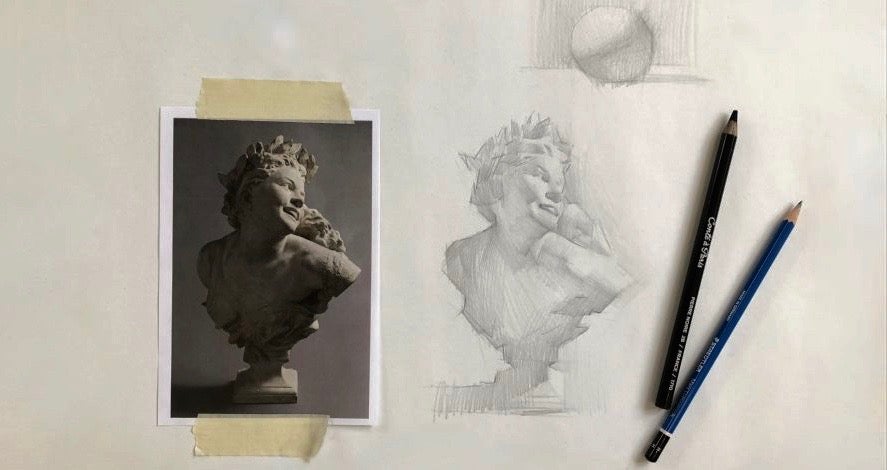
Demo by Marisa
ARTS 1100-01 – Drawing I This course will address the basic technical components of making a work of art through drawing. All levels of experience are welcome, and I will work with each student individually to ensure growth and improvement. We will begin the course working directly from still life and then move to more complex projects (figure, portrait) as the semester continues. Exploration, interpretation, and experimentation are encouraged! Students will build a drawing vocabulary and examine a variety of drawing philosophies that will transcend this course and assist them with the entire experience of making any type of art.
This course is taught by Professor Marisa Stratton.
ARTS 1100-02, -04 – Drawing I

Ian Gresenz, Still life composition

Gus Dotson, Drawing on black paper

Fiona Howard, Figure study
ARTS 1100-02, -04 – Drawing I This is a course on exploring the fundamental elements of art and the art making process using the medium of drawing. Emphasis is on creating an illusion of the three-dimensional world on a flat surface, your paper. Simple techniques that will enable anyone to draw from direct observation of the world around you will be introduced at the beginning of the course. The rest of the course will be dedicated to refining ways to see and finding means of expression. We will draw from still life objects, interior spaces and figure models. A variety of drawing materials including pencil, conté, charcoal, ink and color pastel will be explored. I will support everyone with their decision-making process of drawing. Learn to use formal art elements to build a drawing ultimately in your preferred style whether realistic or more abstract.
ARTS 1100 sections -02 and -04 are taught by Professor Ji Yu.
ARTS 1100-05 – Drawing I
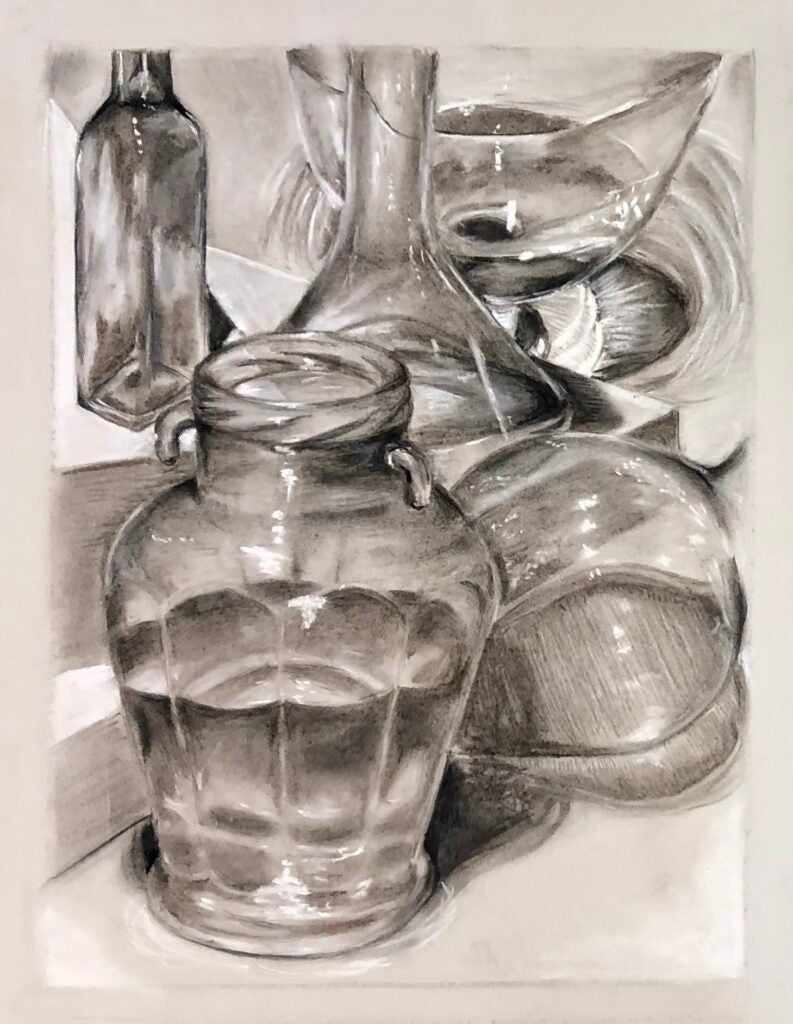
Jenna Royson, Reflections
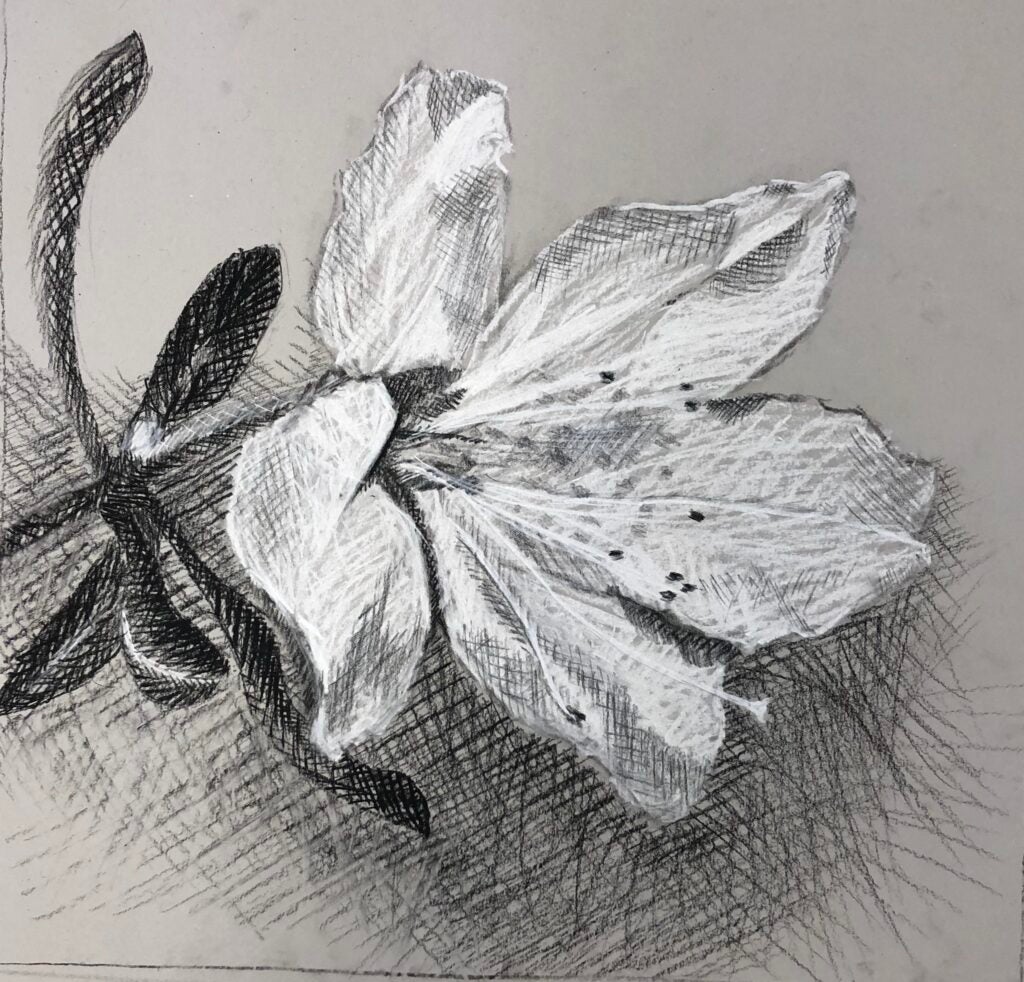
Kent Hall, Flower study
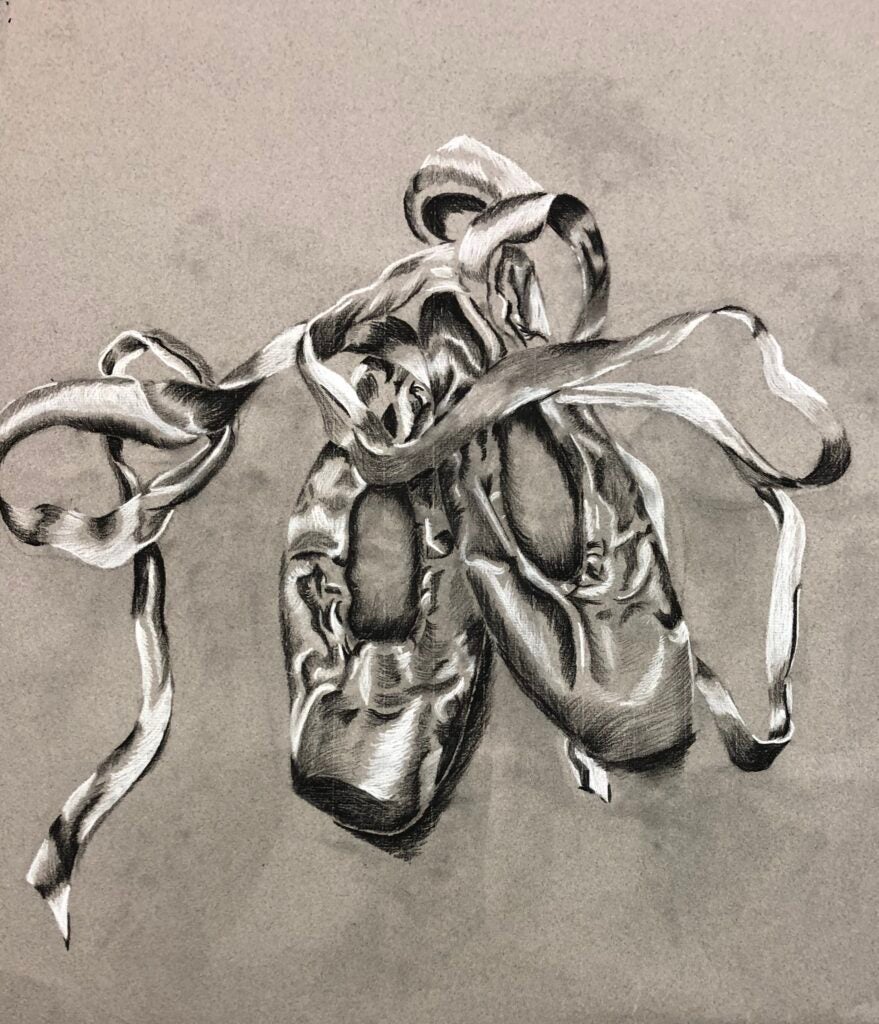
Jade Murphy, Ballet Slippers
ARTS 1100-05 – Drawing I In this course, students explore drawing as a graphic means to process the world around them. The class starts with the fundamentals of composition, and how to use light and shadow to describe form. We then look at line as a means of discovery and expression, along with other techniques of rendering form, space and texture. Projects range from still life and interiors to studies of nature, animal skulls and the portrait/figure. Students are approached on an individual basis as well as through group discussions, slideshows, demonstrations and critiques. “Learning to draw is really a matter of learning to see.” – Kimon Nicolaides.
This course is taught by Professor Ann Schlesinger.
ARTS 2100-01 — Drawing II: Figure
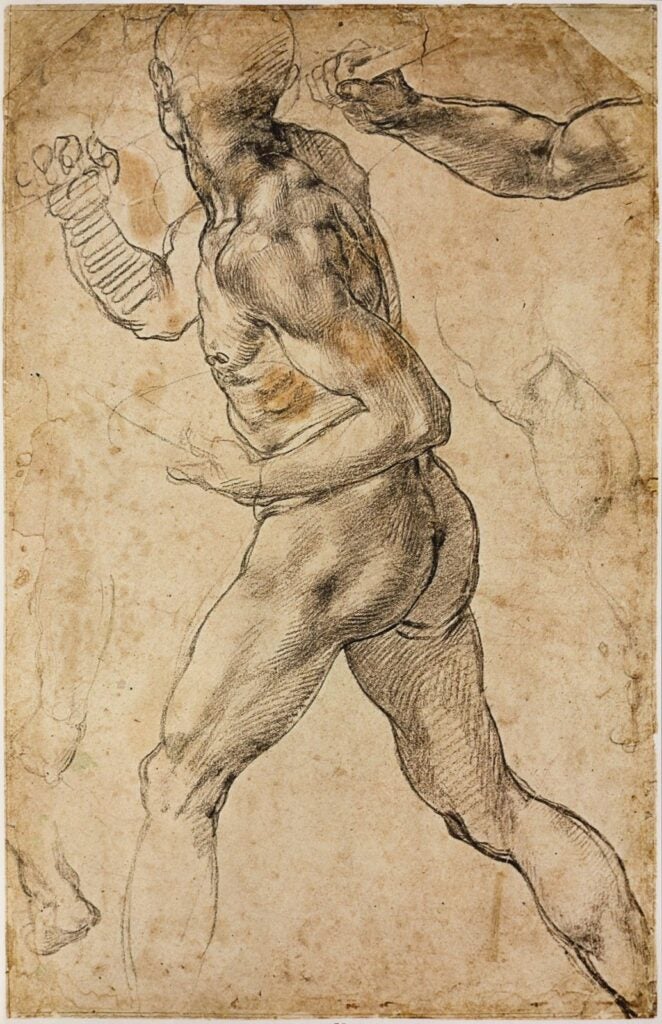
Michelangelo “Figure”
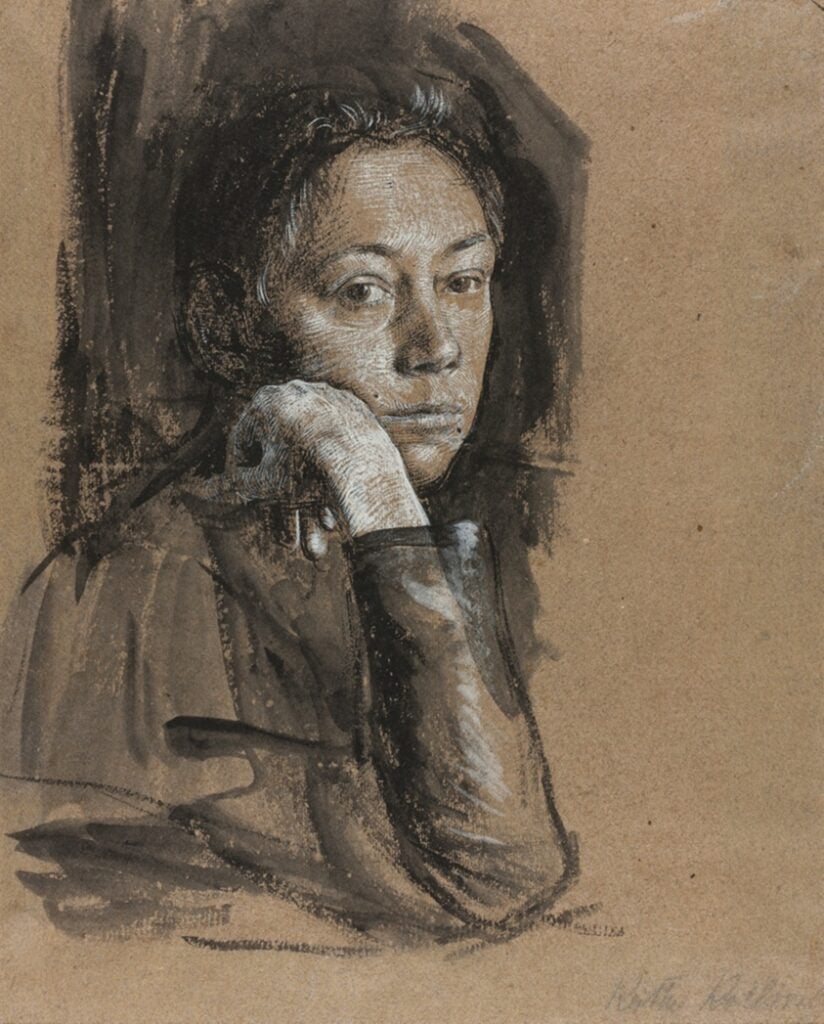
Kathe Kollwitz “Self-portrait”
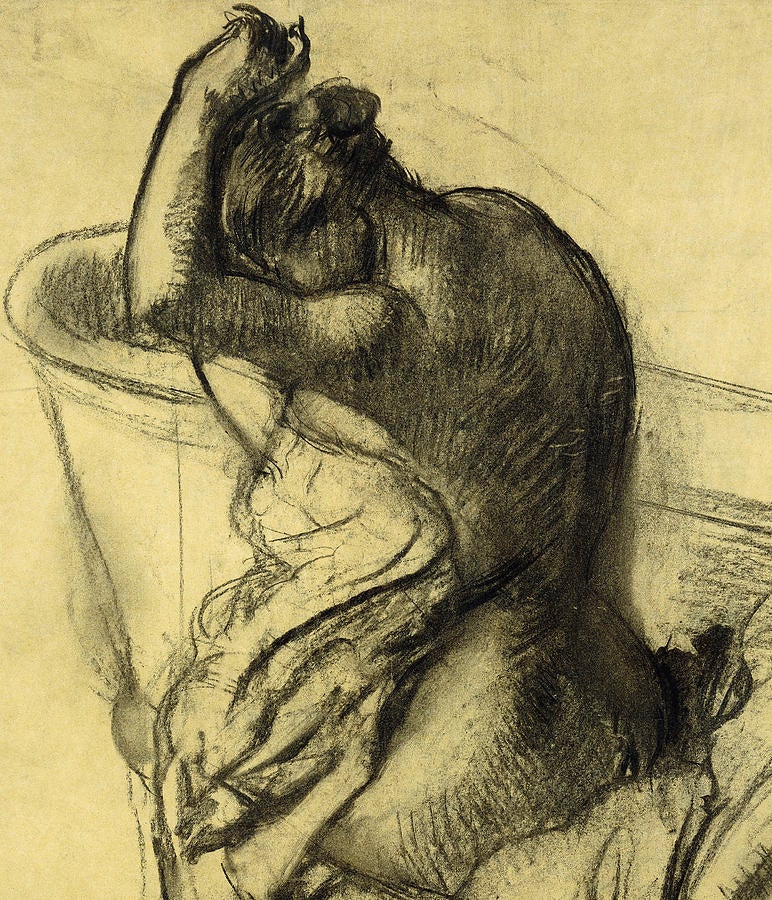
Edgar Degas “After the Bath”
ARTS 2100-01 — Drawing II: Figure Explore the time-honored tradition of drawing the human figure! In this class, students work extensively from the live model, in both short and long poses. Through quick gesture studies, the artist learns to capture natural poses and movement, and in the longer drawings, one gradually comes to an understanding of anatomy and conveying aspects of the human spirit. A range of exercises in which composition, line, value, texture and mark-making allows for both traditional and more expressive approaches to the figure. Portraiture, also, is emphasized, as well as detailed studies of the “human machine” – the skull, skeleton and musculature.
This course is taught by Professor Ann Schlesinger.
ARTS 2101-01 — Drawing II: Wet Media & Ink
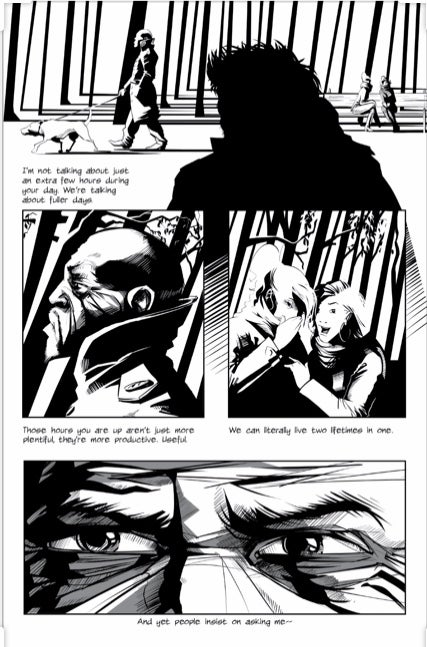
Ryan Colucci, excerpt from R.E.M., 2013

Albrecht Dürer, Study of an Apostle’s Hands (Praying Hands), c. 1508

Student old master copy
ARTS 2101-01 — Drawing II: Wet Media & Ink Every drawing medium has intrinsic characteristics The media of ink and paint (acrylic, watercolor) provide both subtle and dramatic, graceful and explosive effects. Applied with pen, brush, stick and atomizer, the graphic possibilities of these fluid techniques will be explored by creating large-scale works. The course will begin with exercises to introduce pen and ink and brush techniques, in both traditional and experimental styles. These exercises will demonstrate each medium’s value range, color temperature and textural effects. Large drawings will be executed over several class periods. This approach will allow students to fully develop the rich graphic possibilities of the media, and to investigate the character of the subject matter in a thoughtful and expressive way. Assignments will be each student’s reply to particular drawing materials and techniques, and inspiration from artists’ prior work. Students will be given examples of master drawings, and then will be asked to produce an original drawing of their own reflecting their understanding of the historical work. India ink, sumi ink, watercolor and acrylic wash techniques using metal and bamboo pens, sticks, and brushes will be investigated on both wet and dry paper. Emphasis will be placed on developing a strong graphic sensibility, line quality and tonal range. A portfolio of five large drawings done in class will be submitted on the last day of class meetings. Grading will be based on the quality of the works, participation in critiques, and attendance in class. I will meet with each of the students in order to discuss their work. There will be a critique sign-up sheet at the last class.
This course is taught by Professor Erik Sandberg.
Printmaking
ARTS 1201-01 – Printmaking I: Intaglio
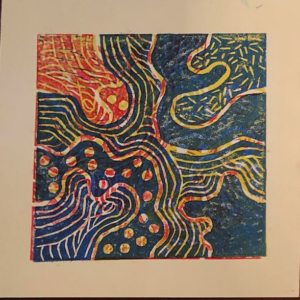
Grace Nguyen
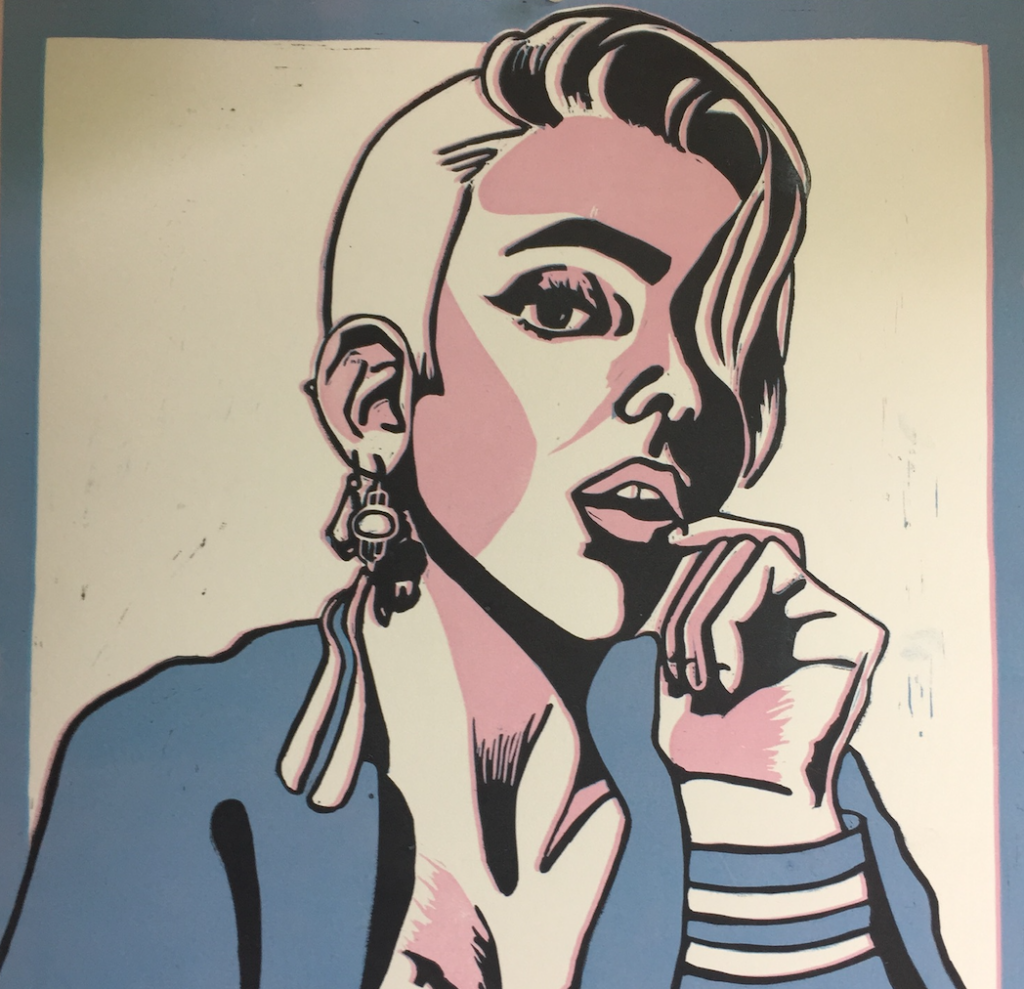
Tyler McConville

Grace Nguyen
ARTS 1201-01 – Printmaking I: Intaglio This course utilizes traditional hand printing of relief images from Linoleum plates. Test plates are done in color and in black and white. Folds and simple bookmaking are presented as options. After learning safe cutting, registration and printing methods, students are encouraged to pursue their own personal imagery. Critiques and view and response of videos and online print-related sites is required.
This course is taught by Professor Scip Barnhart.
ARTS 1603-01 — Art of the Book

Olivia Tatarian
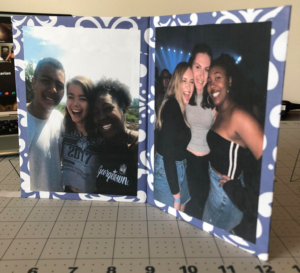
Jordyn Jones
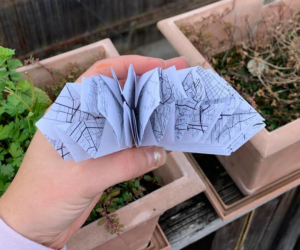
Olivia Tatarian
ARTS 1603-01 — Art of the Book This course explores the practice and creation of unique artist books. Multiple bindings, sewing, folds, cutting methods, and techniques are taught to prepare students for personal expression through handmade books.
This course is taught by Professor Scip Barnhart.
Photography
Darkroom
ARTS 1300-02 – Photo I: Darkroom
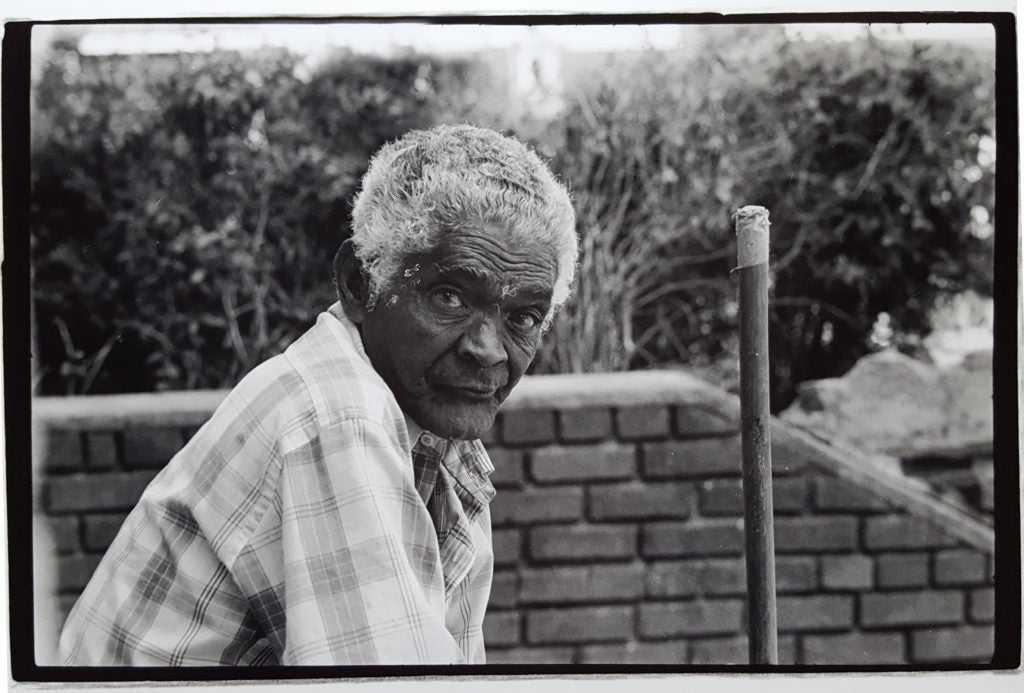
Photo credit to Kelly Carr.

Photo credit to Kelly Carr.
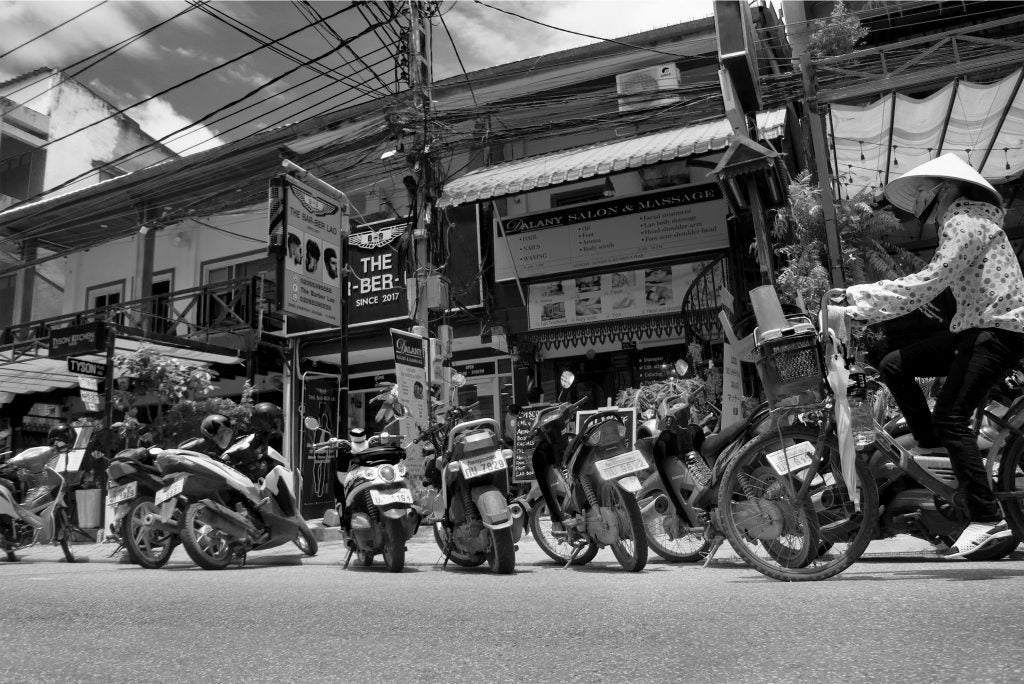
Photo credit to Kelly Carr.
ARTS 1300-02 – Photo I: Darkroom This course has been designed for students who do not have any technical understanding or previous experience with traditional black-and-white film photography. It will cover camera operations, film processing, enlargement printing, and presentation methods; students will expose, develop, and print all of their own images. Information will be conveyed through traditional readings, demonstrations, and hands-on experience with the camera out in the field and print chemistry in the darkroom.
This course is taught by Professor Kelly Carr.
Digital
ARTS 1301-02, -04 – Photo I: Digital
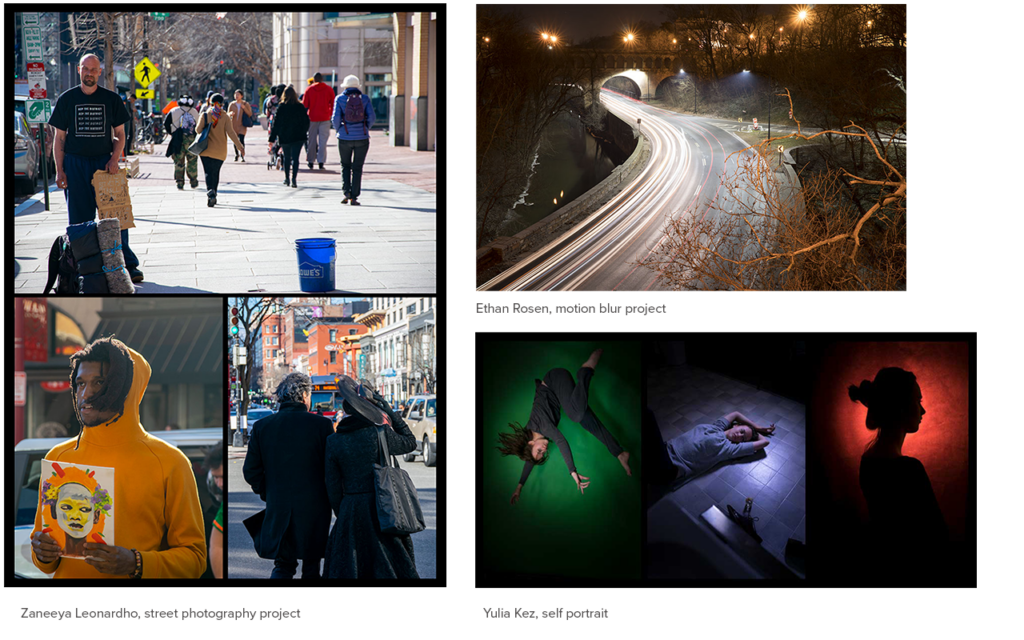
ARTS 1301-02, -04 — Photo I: Digital This is an introductory digital photography studio art course designed to develop the hands-on skills necessary to produce and identify the elements of a good photograph and to acquire a thorough working knowledge of digital equipment. Students will gain an understanding of the aesthetic and technical areas of photography as a fine art. Class lectures, discussions and digital lab assignments will deal with photographic composition, criticism and history, camera and paper types, and printer systems. Fundamental knowledge of computer programs such as Photoshop will be covered for students to edit and print their work. Students enrolled in studio courses must devote a minimum of 4 to 6 hours per week outside of class to develop and complete assignments. Through the analysis of the history of this medium this class involves the study of photography as a metaphor for the human condition with students engaging in self-reflection and questioning through analysis, inquiry, dialogue and creation.
ARTS 1301 sections -02 and -04 are taught by Professor Roberto Bocci.
ARTS 1301-03 – Photo I: Digital

Natalie Sanders, Long Depth of Field

Valerie Sanchez, Summer 2020
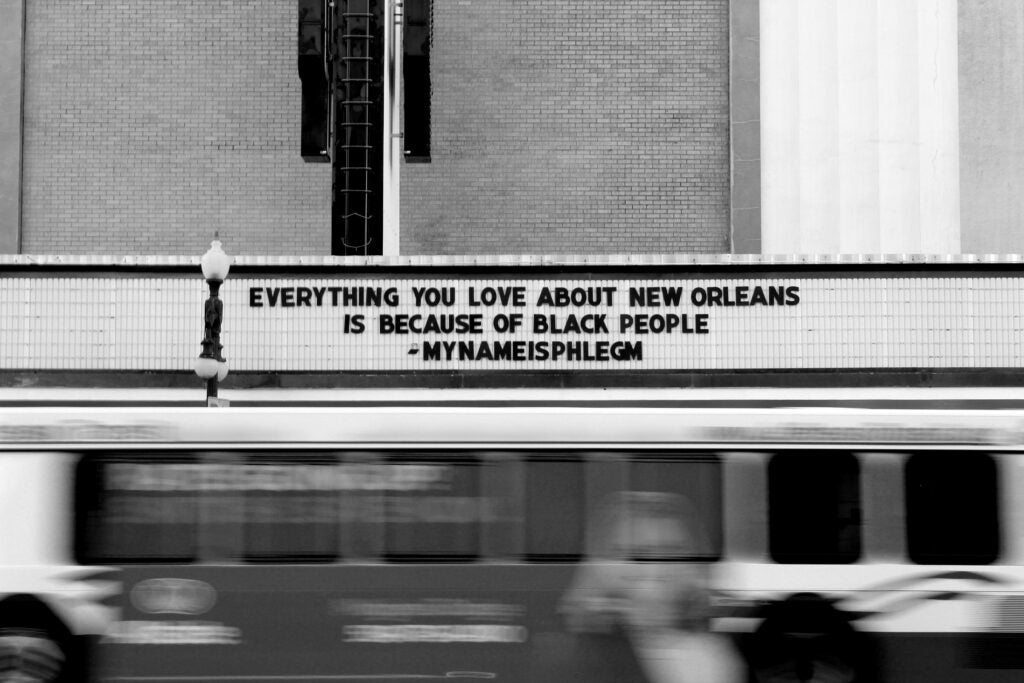
Leo Arnett, Summer 2020
ARTS 1301-03 – Photo I: Digital This is a basic digital photography studio art course designed to develop the hands-on skills necessary to produce and identify the elements of a good photograph and to acquire a thorough working knowledge of digital equipment. Students will gain an understanding of the aesthetic and technical areas of photography as a fine art. Class lectures, discussions and digital assignments will deal with photographic composition, criticism and history. Fundamental knowledge of computer programs such as Photoshop will be introduced in the semester to develop photographic imagery.
This course is taught by Professor Kelly Carr.
Sculpture
ARTS 1400-02 & 1400-03 – Sculpture I
There are two sections of 1400, at different times.
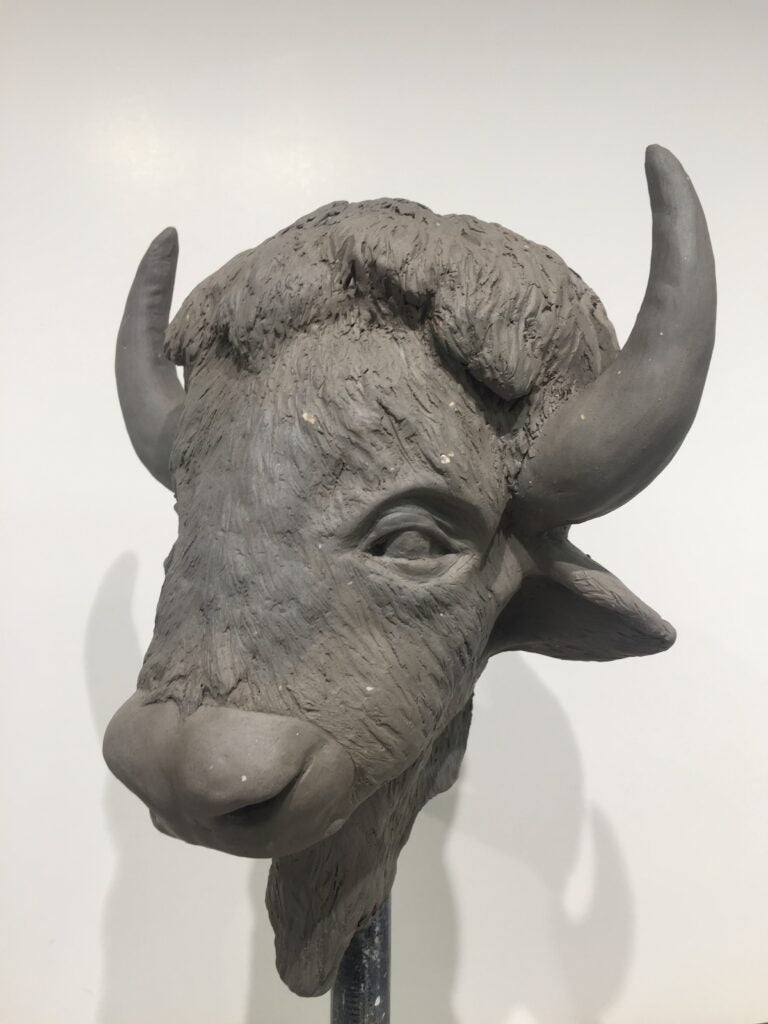
Sidney Lee, Modeling from life

Sean Letendre, Cardboard self-portrait

Corine Forward, Spring 2019, Micro Monument Assignment
ARTS 1400-02 & 1400-03 – Sculpture I Sculpture I offers students the opportunity to exercise their creative drive through making three-dimensional form. Students work in traditional and contemporary methods and materials. During the semester there are three thematically driven projects that simultaneously introduce new materials, processes, and conceptual consideration. The semester will include projects that range from modeling a form in clay, creating sculptures with recycled cardboard, and using found objects to construct a sculpture. This course is designed for the novice sculptor and assignments emphasize foundational skills.
Please note that the Sculpture Studio is located in the basement of the Walsh building, down one flight of stairs. This room is not wheelchair accessible.
Both sections of ARTS 1400 are taught by Professor Evan Reed.
Painting
ARTS 1500-01 – Painting I: Oil

Still Life by Allie Stevens
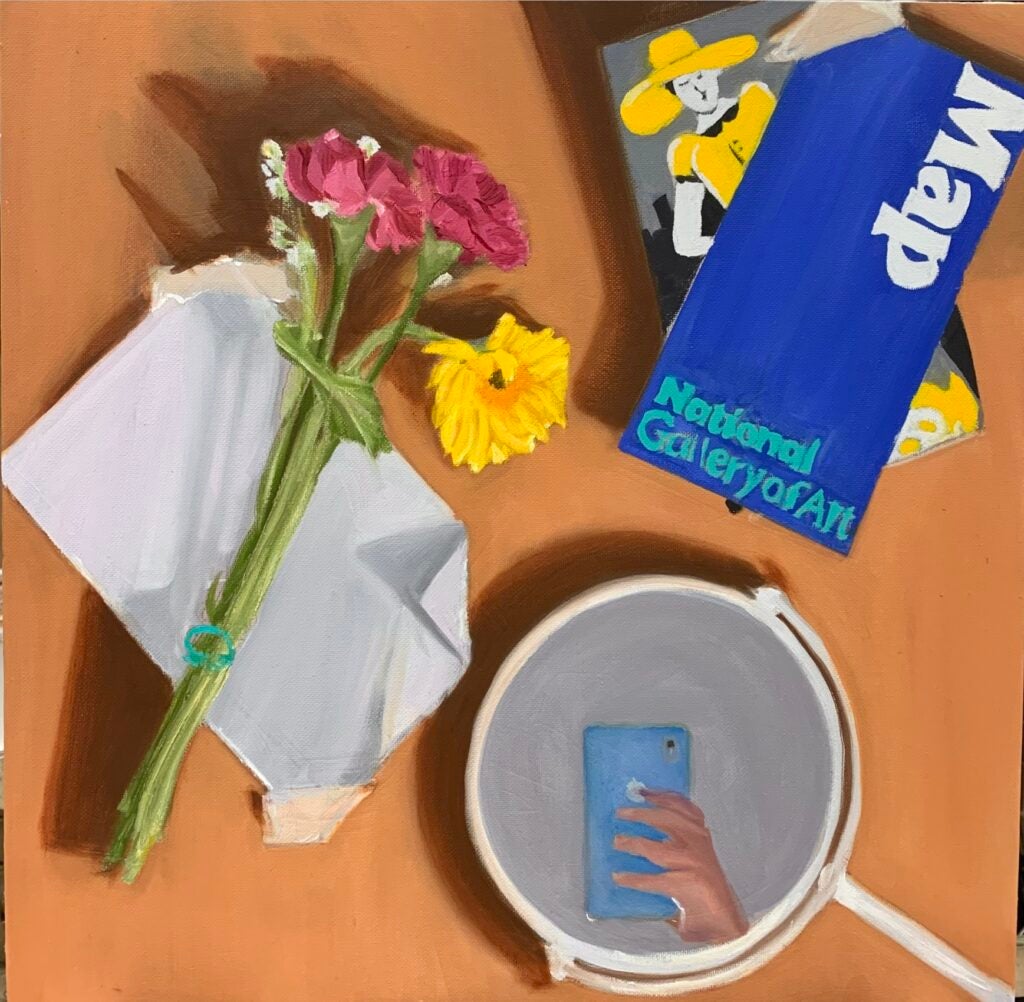
Trompe L’oeil Still Life by Nicole Keller

Trompe L’oeil Still Life by Kayla Zamanian
ARTS 1500-01 — Painting I: Oil This course will address the basic components of making a work of art through oil painting. All levels of experience are welcome, and I will work with each student individually to ensure growth and improvement. We will begin the course working directly from still life and then move to more complex projects as the semester continues. The course will provide historical context for traditional methods of oil painting, as well as contemporary modes of making. Exploration, interpretation, and experimentation are encouraged! Students will build a painting vocabulary and examine a variety of painting philosophies/methods that will transcend this course and assist them with the entire experience of making any type of art.
This course is taught by Professor Marisa Stratton.
ARTS 1500-02 – Painting I: Oil

Zoom Black and White Demonstration
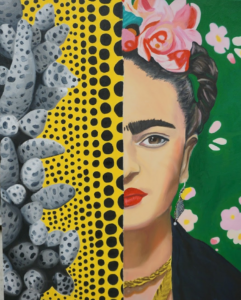
Melissa Gonzalez, Collage Painting Project

Susanna Hermann, Multiplicity Painting Project
ARTS 1500-02 – Painting I: Oil This is an introductory painting course that teaches the basic techniques of painting. Students learn to paint from observation, in a manner that results in a realistic depiction of the subject. However, the goal of this course is not to make copies, but to strike a balance between an art historical approach to painting with a contemporary one – fostering an environment that encourages students to think creatively and to experiment with the paint and the subject. This is achieved through live demonstrations, artist slide lectures, group, and individual critiques.
This course is taught by Professor Scott Hutchison.
ARTS 1500-03 – Painting I: Oil
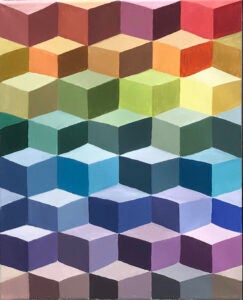
Julia Tolfa.
Oil on canvas.
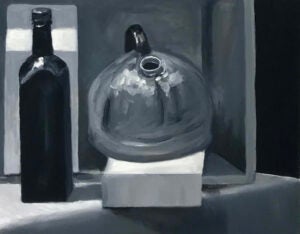
Ethan Clark
Oil on canvas.
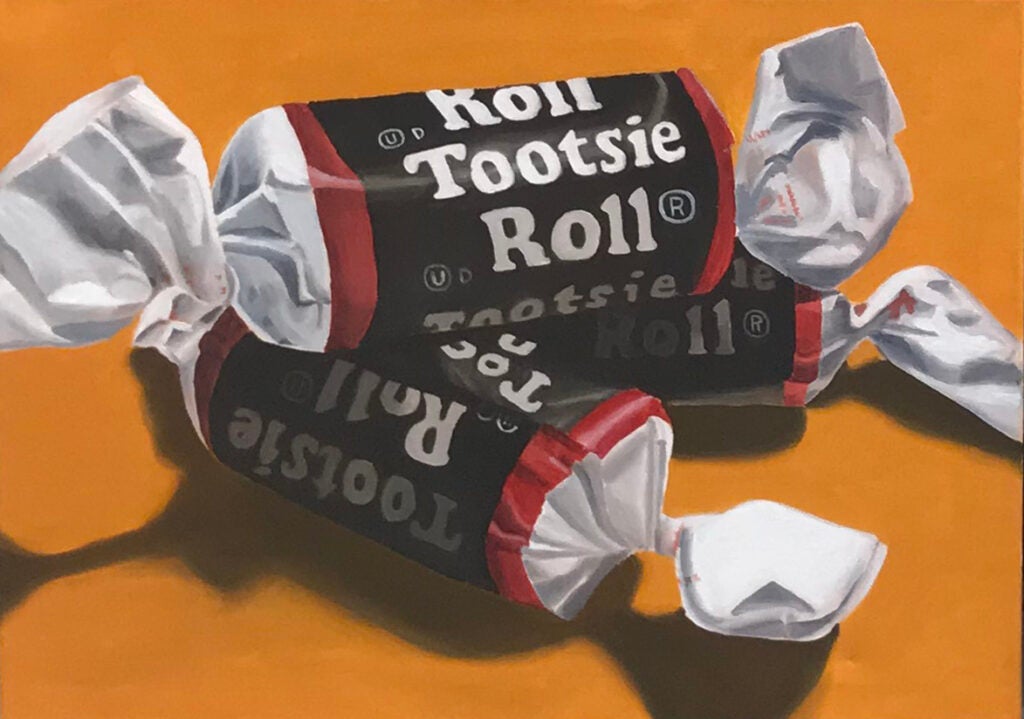
Julia Tolfa.
Oil on canvas.
ARTS 1500-03 — Painting I: Oil This is a studio art class developing the techniques and concepts of painting in traditional, oil medium used from the Renaissance to today. Students will learn the basic techniques of transparent glazing and opaque oil painting. They will investigate the impact of color and value on the illusion of space and form. While focusing on the traditional subjects of landscape, still life, and figure, they will create a portfolio of three paintings developing their drawing and painting abilities with the medium. Studio demonstrations, lectures, slide presentations and individual and class critiques will be conducted online using Zoom and Canvas to present all aspects of instruction. Students create oil paintings during regular class sessions with feedback from the instructor. They continue to develop their paintings outside of class. The students receive individual guidance and evaluations from the instructor during each class as well as valuable insights from the student discussions during class critiques.
This course is taught by Professor Erik Sandberg.
ARTS 1501-01 – Painting I: Acrylic
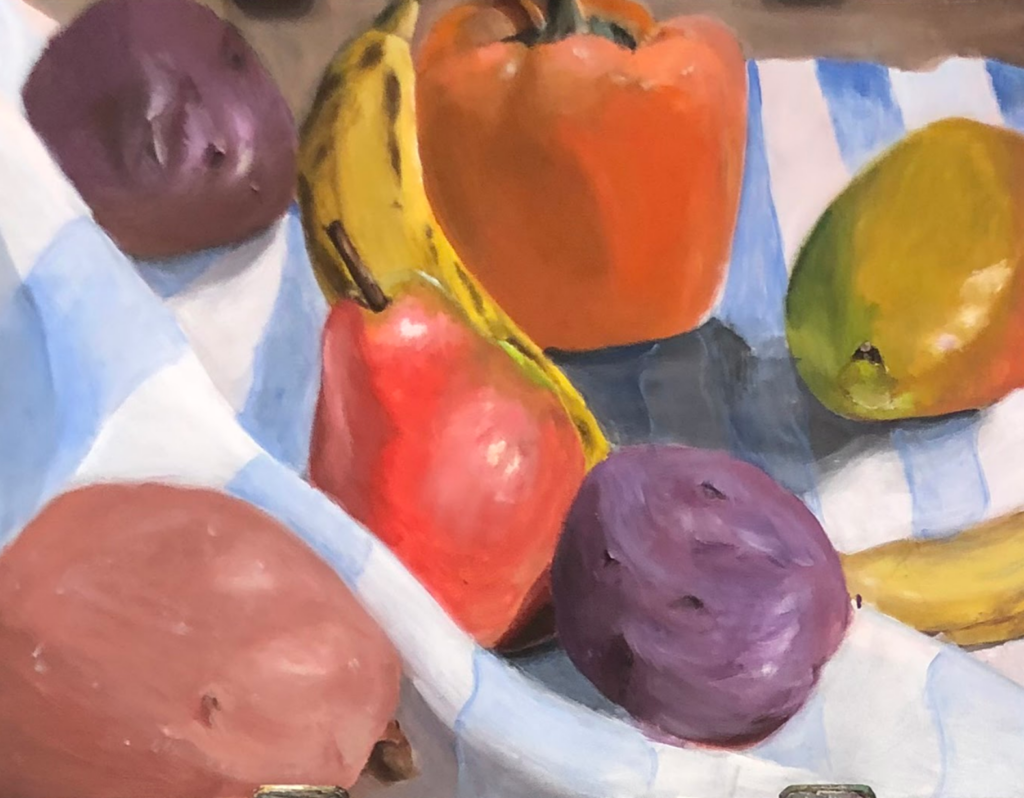
Project 3: Fruit with multiple colors
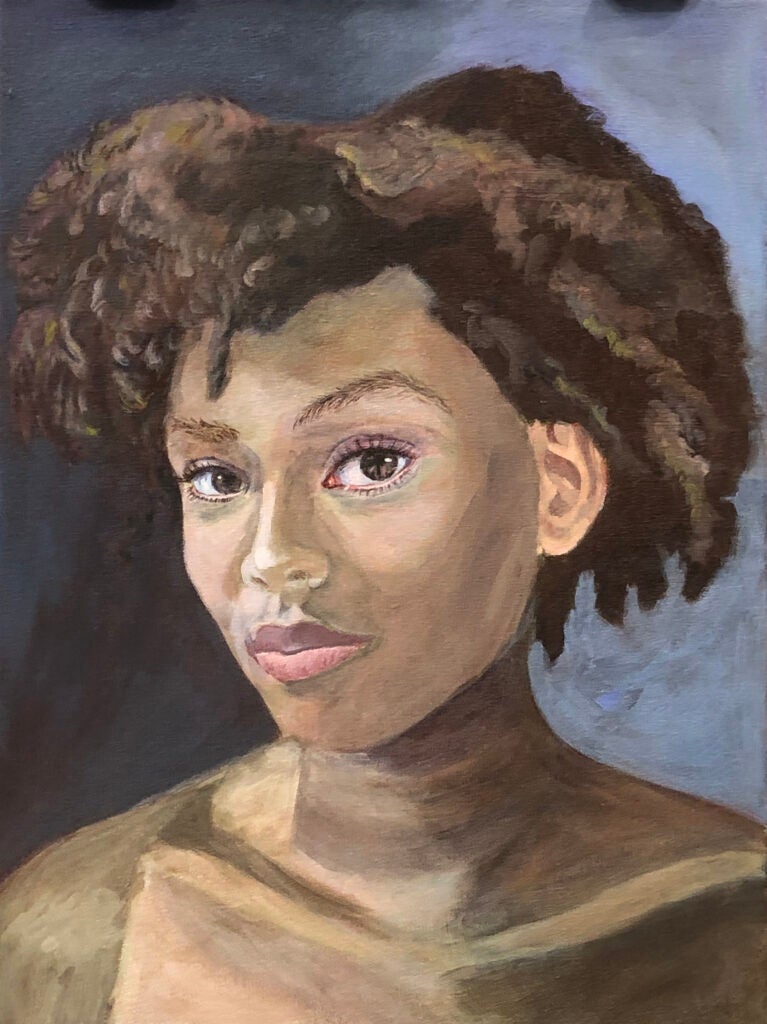
Allemai Dagnatgchew, Project 4: Self-portrait

Cristina Macaya, Fragmented Self
ARTS 1501-01 – Painting I: Acrylic This is an introductory course that consists of lectures and studio labs. This course focuses on both the acquisition of fundamental knowledge of acrylic painting, and the creation of paintings using one’s own unique imagery. Relevant art historical references and resources will be introduced in order for students to contextualize their work in reference to art history. Students will utilize critical thinking and problem-solving skills by doing progressively challenging assignments. As they work on these assignments throughout the semester, they will develop a more sophisticated aesthetic approach in the areas of color, composition, perspective, balance, and subject matter. There will be five class critiques (four critiques for each individual assignment and the last final critique for the entire course) throughout the semester and each student will have opportunities to discuss their work as well as the work of others.
This course is taught by Professor BG Muhn.
ARTS 2500-01 — Painting II
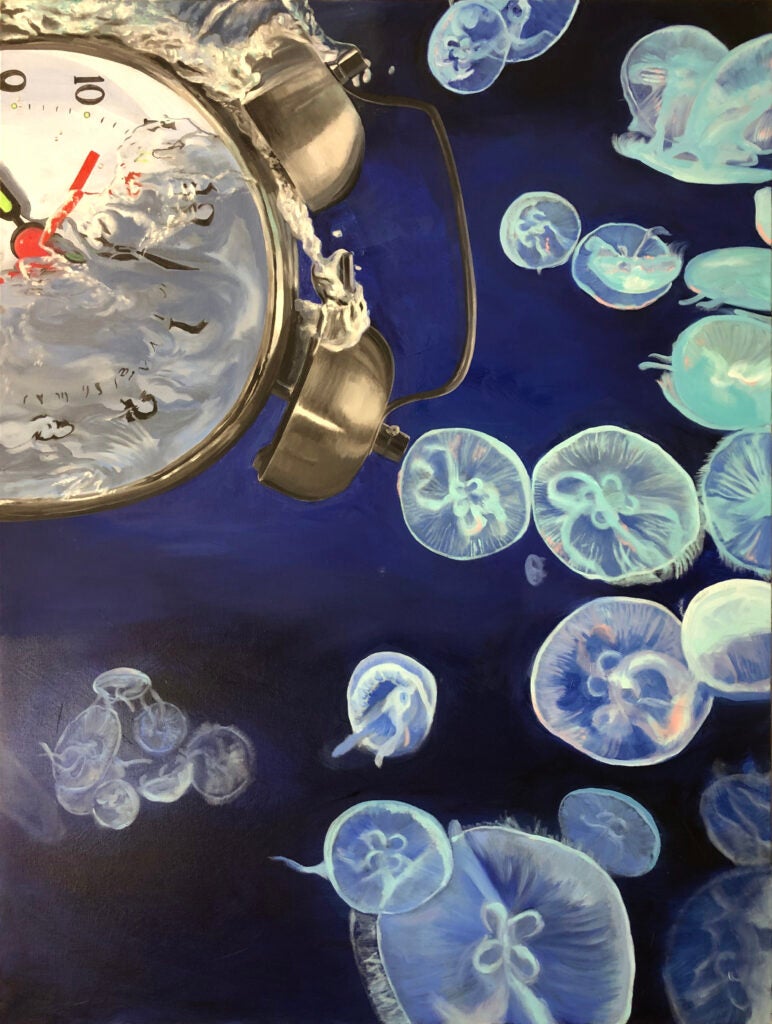
Jude An, Project 1: Conceptual Container
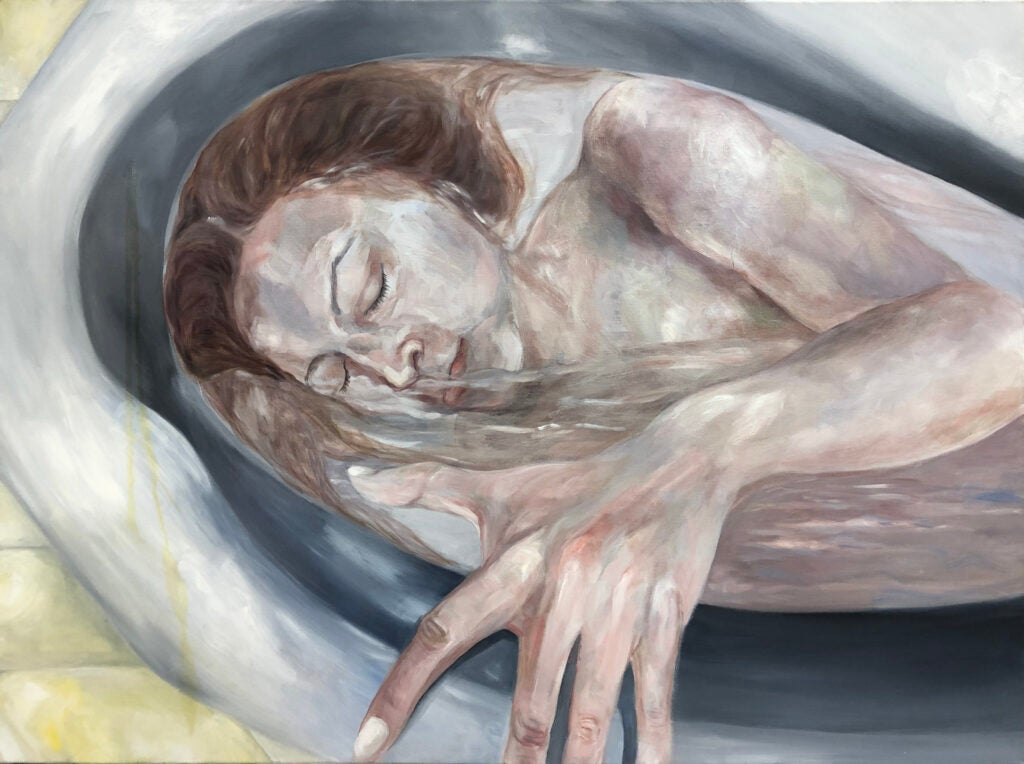
Christina Shoucair, Project 1: Conceptual Container
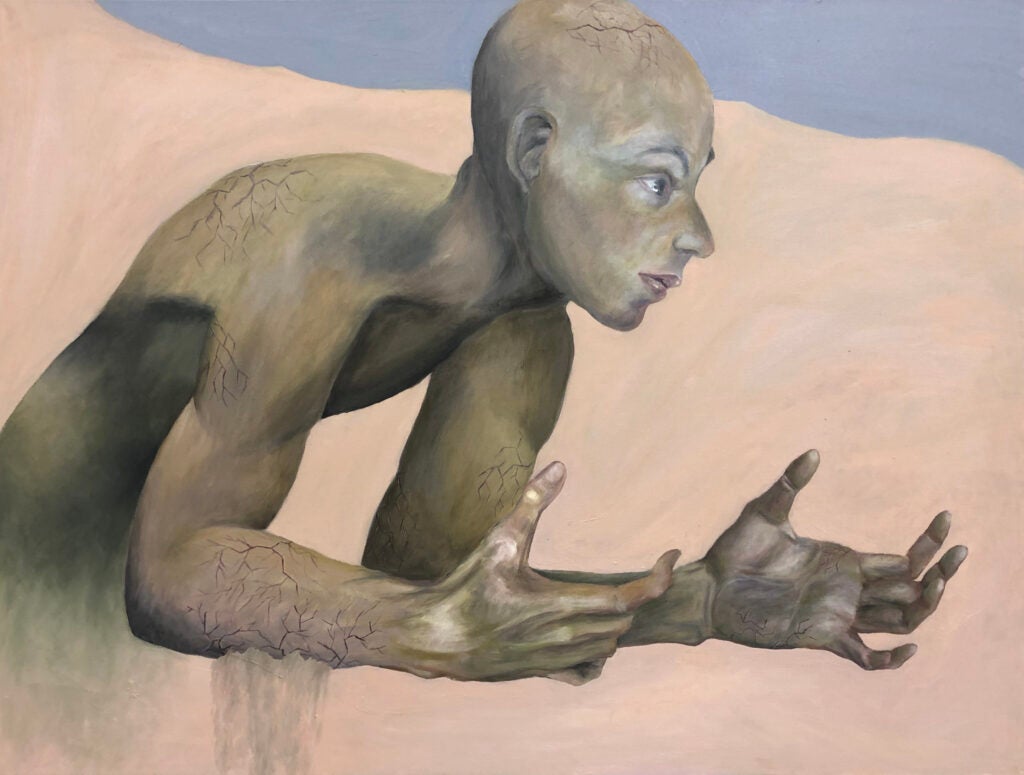
Sharon Huynh, Project 2: Human Body
ARTS 2500-01 — Painting II This is an intermediate-level painting course. The overall theme of the assignments for the semester is moving away from straight observational painting and exploring imagination and visual dynamism within a juxtaposition of the real and the unreal, blurring the boundaries bet
ween dream and reality and consciousness and the subconscious. This will be the overarching idea for all three projects while each project deals with a specific subject matter. Relevant references and resources will be introduced for students to contextualize their work using art history. Assignments begun in class will require time outside of class to develop and complete. Medium: either oil or acrylic.
This course is taught by Professor BG Muhn.
Design
ARTS 1600-01 – Design I

Camouflage Project: In Design I, we cover color mixing and color theory. In this project, by Elena Zheng, the students were asked to think about the idea of camouflage and how to integrate two or more natural or man made objects by thinking about their color placement and arrangement.
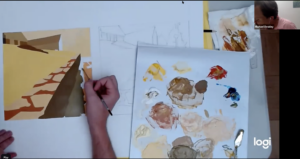
Experimental color compositions: In this project (seen here: Professor Dowley’s demonstration) students use their own photographs of architectural spaces to develop two simplified color compositions. One of the compositions will be monochromatic (one primary color is chosen as a starting color) and the other is developed from complimentary colors.

Paper Cutting: Students learn to cut intricate designs using only paper and x-acto knives. Students develop their images from their own photography and from drawings.(student work: Cornelia Thomas)
ARTS 1600-01 — Design I This is an introductory art studio course. Using drawing, painting, sculpture and photo materials, students learn the principles and elements of design necessary to communicate and express themselves visually. Special topics include collage and papercutting.
This course is taught by Professor Michael Dowley.
Graphic Design
ARTS 1602-01, -04 — Graphic Design I
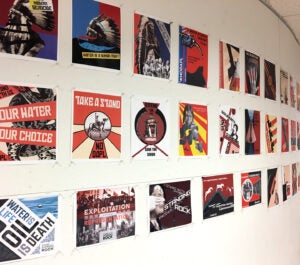
Dakota Access Pipeline protests, also called by the hashtag NoDAPL. Students had studied the bauhaus design and did research on the DAPL and created poster designs.

After learning the tools in illustrator and talking about branding and typography students design a logo, do variations and design business cards for the business and learn about the printing process. Work by Michelle Motta.
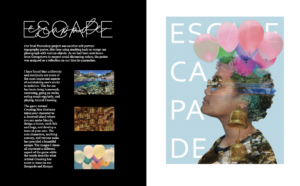
Students learn to do a portfolio newsletter in InDesign for their projects. This a spread from Nia Jordan’s portfolio.
ARTS 1602-01, 04 — Graphic Design I: Students will learn the formal, aesthetic, and communicative aspects of creating effective graphic images. Projects include logos, typography, and digital arts that promote mastery of techniques, methods, and materials. In order to foster creativity, we start with breathing meditation at the start of class, followed by discussions about design and learn the Adobe software and the foundation of design principles. The goal of this class is to strengthen students’ visual literacy and communication skills as part of their liberal arts education.
Sections -01 and -04 of ARTS 1602 are taught by Professor Negar Nahidian.
ARTS 1602-03 – Graphic Design I

Student multilingual print and interactive magazines based on chosen topic, major or minor
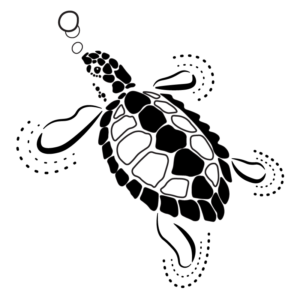
Chiara Lewis, translation drawings, pre-logo

Angela Perez, logo design and branding, laser etched and cut Maker Hub promo item
ARTS 1602-03 — Graphic Design I: This is a studio art class focused on the creation of graphic design assets for print and screen-based media. During this course, you will learn basic Adobe Illustrator, Adobe Photoshop, and Adobe InDesign software through real-world projects and current topics in graphic design. The course seeks to familiarize design students with the communicative power of visual form and to help students develop a personal process of creating original graphic forms capable of effectively communicating a message or information. Projects integrate the following topics: principles of graphic design, design research, logos and branding, album cover design, interactive and print publication design, typography, graphic design history, and professional portfolios.
This course is taught by Professor Toni-Lee Sangastiano.
Animation
ARTS 1700-01 — Animation I
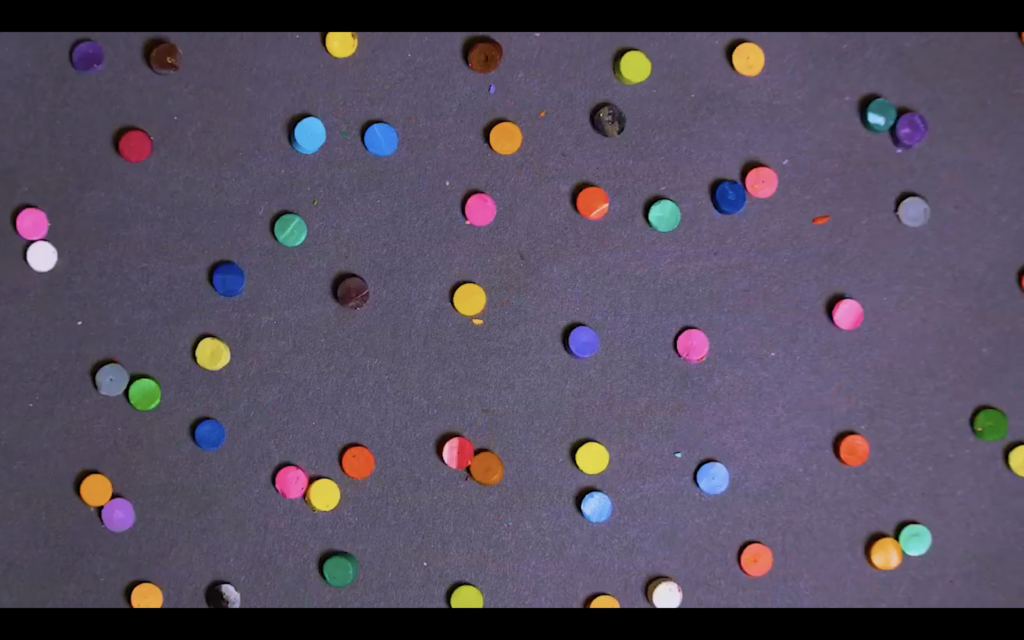
Screengrab from film by student Sarema Shorr
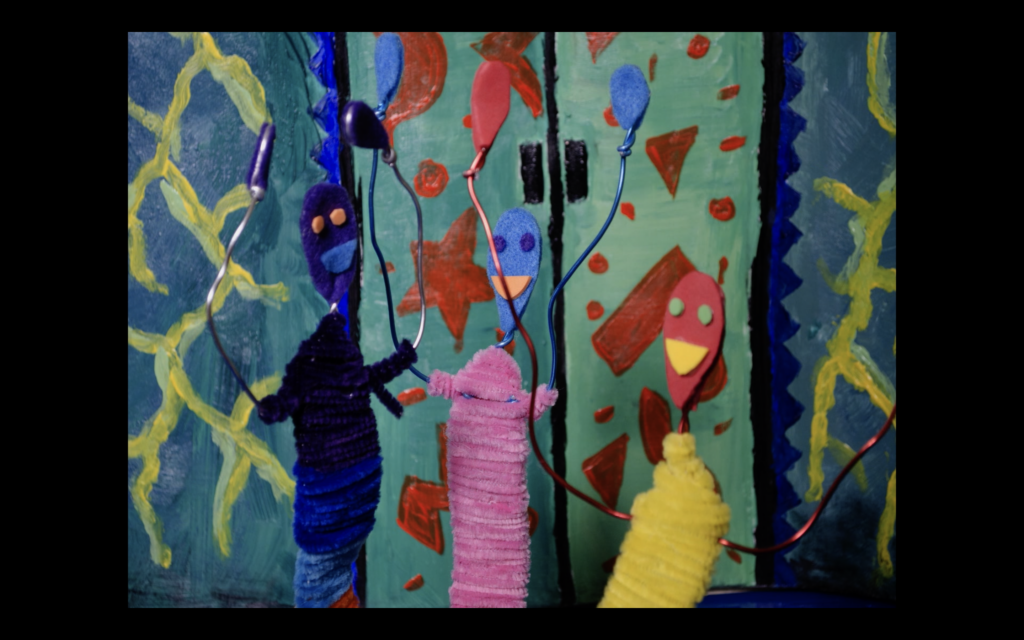
Screengrab from film by student Renata Garcia

Screengrab from film by student Shana Shin
ARTS 1700-01 — Animation I: This course is designed to introduce students to basic methods and practices in animation while exposing them to artists working independently in the field. The course will provide an overview of techniques ranging from hand-drawn frame-by-frame animation, to object animation and pixelation. Each class will consist of a short demonstration, viewing of related works, hands-on experimentation, and critique. Weekly assignments will further students’ exploration of animation approaches and techniques. The course will conclude with the creation of final projects in which students will develop and create an animated short in a medium of their choosing.
This course is taught by Professor Elyse Kelly.
ARTS 4960 — Senior Project Seminar The Senior Project seminar is a three-credit course offered in the fall semester as a requirement for graduating majors in studio art. The purpose of the seminar is three-fold: to provide practical knowledge needed to begin a career as a professional artist, to offer a foundation in contemporary art and art theory, and to prepare students for their thesis art project and Senior Exhibition. The lecture and discussion-based course includes several writing assignments, culminating in a research paper. This course includes weekly lectures and discussions, guest speakers and field trips, readings, group critique and written assignments. Students will gain a better understanding of their place in the art world, the opportunities and challenges facing artists, and the resources and tools available to them. As this course serves as the writing requirement for art majors, we will explore art writing in-depth specifically as it relates to your art-making practice and the broader field of art writing in general. Finally, the course will prepare students for their thesis, the Senior Art Exhibition, which is shown in the de la Cruz Gallery each subsequent spring.
This course is taught by Professor Brady Robinson.
Upper Level ARTS Courses
ARTS courses at the 3000-4000 level are designed primarily for Art Majors, Minors and advanced students who want to work with a professor on one or several independent projects over the course of the semester. These courses require approval. Please inquire with the individual instructor for more information.
These courses include:
- ARTS 3200-01 Printmaking III: Directed Study I – Scip Barnhart
- ARTS 3300-01 Photo III: Directed Study I – Roberto Bocci
- ARTS 3400-01 Sculpture III: Directed Study I – Evan Reed
- ARTS 3500-01 Painting III: Directed Study I – Scott Hutchison
- ARTS 3500-02 Painting III: Directed Study I – BG Muhn
- ARTS 3700-01 Animation III: Directed Study I – Elyse Kelly
- ARTS 4300-01 Photography Studio IV: Directed Study I – Roberto Bocci
- ARTS 4500-01 Painting IV: Directed Study I – BG Muhn
- ARTS 4500-02 Painting IV: Directed Study III – Scott Hutchison
Art History Courses
ARTH 1111-01 — Art and the Body
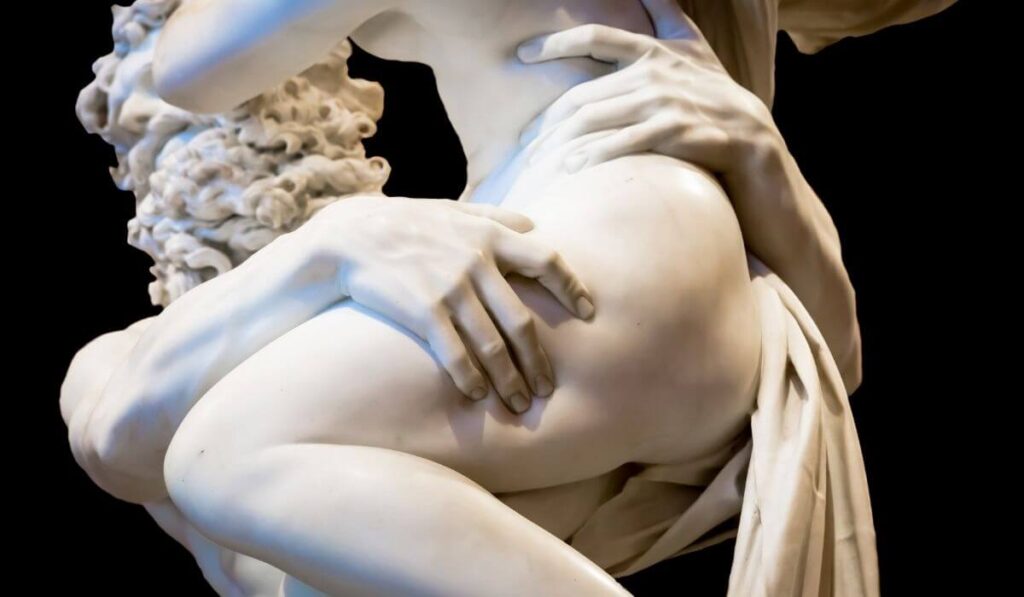
Detail of Gian Lorenzo Bernini’s “Rape of Proserpina” (1621-22) marble, Villa Borghese, Rome.
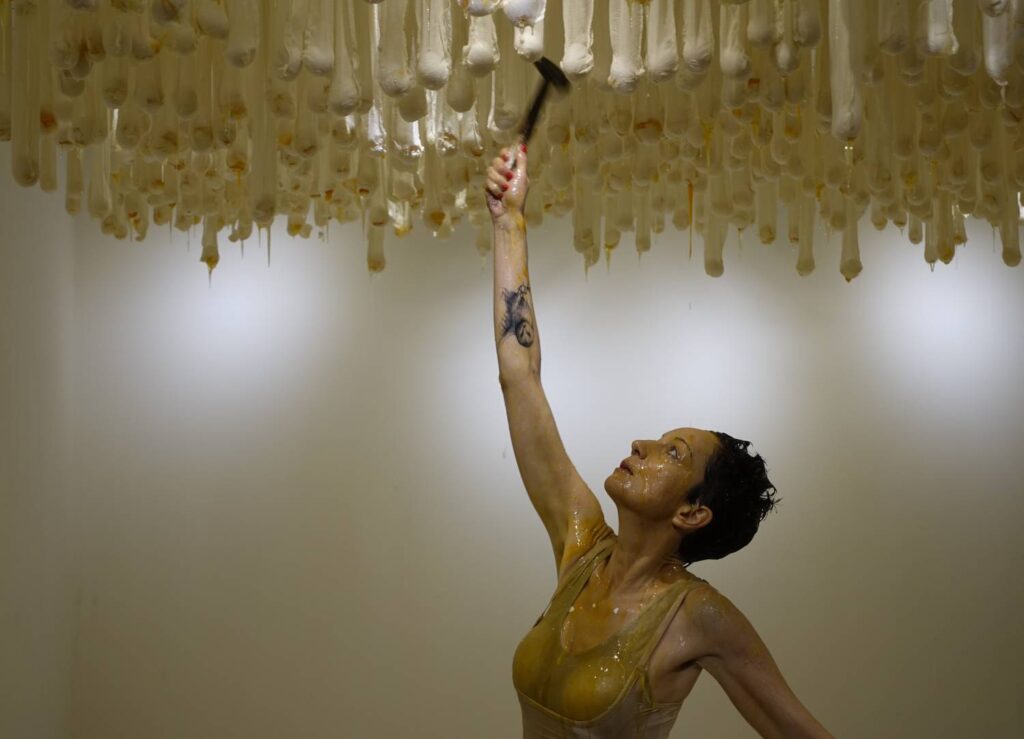
Documentary photograph of Marta Jovanović’s performance “Motherhood” (2016), Belgrade © Jan Eugster

Photograph of Michelangelo Pistoletto viewing his mirror self-portrait “QR code Possession” (2019-2023) at the opening of the show “Michelangelo Pistoletto. Molto di Uno (Many of One)” Castello di Rivoli Museo d’Arte Contemporanea, Rivoli-Torino.
ARTH 1111-01 — Art and the Body Perception is more than just seeing. To experience art requires the use of our senses–sight, smell, touch, taste, and hearing. It can also enlist the “sixth sense” of proprioception, as well as kinesthesia, balance, and sentiment. Drawing on the fields of neuroarthistory, somaestheics, and the history of the senses, this course examines the relationship between art, science, and cognition across historical periods of visual and material culture. Our course aims to analyze the various ways that artists and spectators engaged with artworks through sensate data, stimulation, and responses. This course explores how the historical development of the “sensuous” played an integral part in the ways artists from the Medieval period to contemporary art consider the spectator’s senses central to the creative process. Students will survey topics such as: visuality, aurality, haptics, imagination and memory, pain and suffering, erotics and temptation, consumption and appetite, virtual and augmented reality, and kinesthesia through a wide variety of media. Cross-culturally, the senses are not limited to the traditional five Aristotelian categories, making sensory perception dynamic and variable within cultural and social groups and across time periods.
This course is taught by Professor Tiffany Hunt.
ARTH 1240-01 — Ancient to Medieval Art
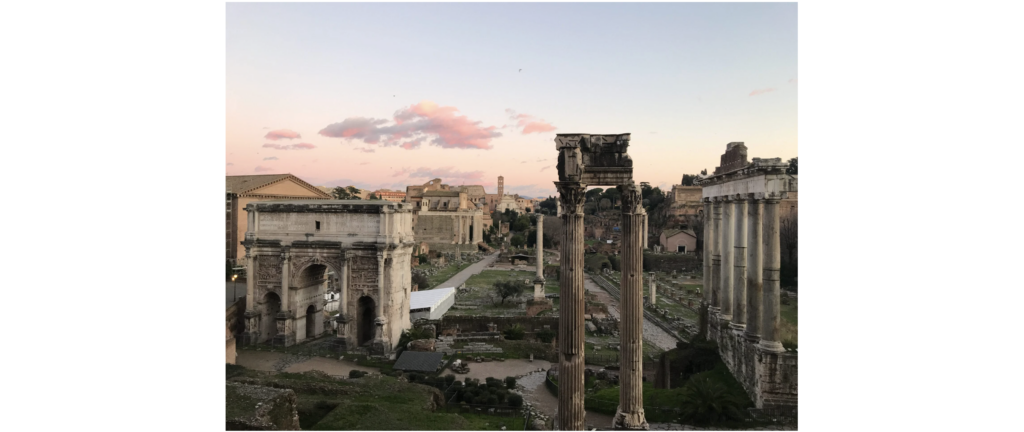
View of the Roman Forum – taken in December 2019 by Prof. Tilney
ARTH 1240-01 — Ancient to Medieval Art This course surveys the art and architecture from the Paleolithic period through the Gothic period. Within a roughly chronological structure, we will explore the art of these periods in relation to their broader cultural, intellectual and historical contexts. In addition to emphasizing the developments that define each historical period, we will consider the aesthetic advances made with the painting materials and methods available at the time
This course is taught by Professor Barrett Tilney.
ARTH 2120-01 — Chinese Art
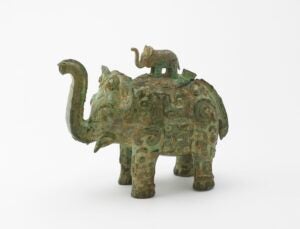
Lidded ritual ewer in the form of an elephant with masks and dragons, Shang Dynasty (China), ca. first half 11th century BCE, bronze, Freer Gallery of Art, F1936.6a-b
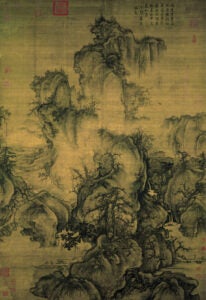
Guo Xi, “Early Spring,” Northern Song Dynasty (China), 1072, hanging scroll, ink and light color on silk, National Palace Museum, Taiwan
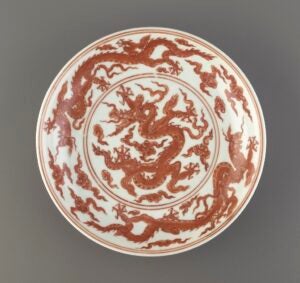
Dish with design of dragons and clouds, Ming Dynasty (China), Xuande Reign, 1426-35, porcelain with cobalt under clear glaze, enamel over glaze, Freer Gallery of Art, 1965.4
ARTH 2120-01 — Chinese Art This lecture course surveys the art and architecture of China from the prehistoric period to the present-day. The unfolding of various artistic and architectural traditions in China was marked by regional developments, the emergence of different religious and philosophical systems, as well as by interactions with China’s neighbors. The topics that we will study include: bronze ritual vessels, Buddhist cave shrines, landscape painting, ceramics for domestic use and international trade, gardens and literati or gentlemanly culture, the impact of the Jesuits upon Chinese court arts, and the response of modern artists to traditional artistic techniques as well as to the dramatic upheavals of 20th century China. Emphasis will be placed upon the interrelationship between the visual properties of art objects and their materials and techniques, as well as the historical, social, and cultural contexts of their production. No prior knowledge of Asian art is required or assumed.
This course is taught by Professor Michelle Wang.
ARTH 2311-01 — Global Medieval
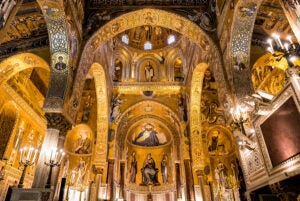
View of the Apse and sanctuary mosaics in the Cappella Palatina (c. 1140-1170 CE), Sicily.
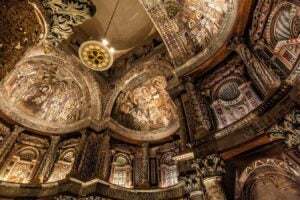
View of the triconch sanctuary frescoes in the Red Monastery (Monastery of Apa Psoi) (7th-8th Century CE), Souhag, Egypt
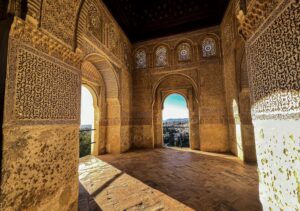
View of horseshoe arched widow and multi foil arch with Islamic calligraphy in the walkway of the Alhambra (c. 1238) Granada, Spain.
ARTH 2311-01 — Global Medieval Artistic Capitals in Medieval Period coincide with rise and fall of global empires– from the First Golden Age of Byzantium under emperor Justinian (527 CE) to the final crusade and the Siege of Acre (1291 CE). While the popular idea of the Medieval Age as portrayed in television shows casts a “dark age” filled with war, plague, and rampant conflict, the visual and material culture reveals a wealth of activity. During this period the transportation of material goods, circulation of artistic practices, and mobility of ideas across geographies led to networks of connectivity between Constantinople and Cairo, Jerusalem to Rome, and Granada to Sicily. This course examines how art objects (painting, sculpture, textiles, manuscripts, ivories, enamels, and relics) and architecture allow us to recover and retrace the cross-cultural movements both within a European context and beyond. Students will consider issues of patronage, messaging and propaganda, race and cultural migration, trade routes and mechanisms of exchange, and the dynamic rise of artistic capitals
This course is taught by Professor Tiffany Hunt.
ARTH 2542-01 — Northern Renaissance
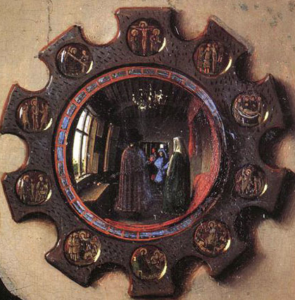
Jan van Eyck, Arnolfini Double Portrait (detail), 1434, London, National Gallery
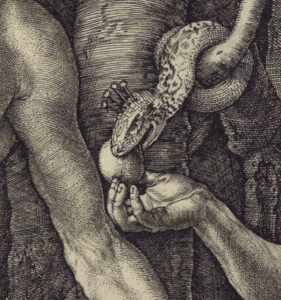
Albrecht Dürer, Adam and Eve (detail), 1504, Washington DC, National Gallery of Art
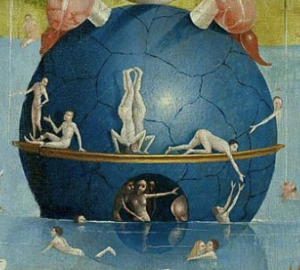
Hieronymus Bosch, Garden of Earthly Delights (detail), c. 1510, Madrid, Museo del Prado
ARTH 2542-01 — Northern Renaissance This course explores art made in the Netherlands, Germany, and France c. 1300-1575, which includes an amazing variety of work produced for courts, churches, civic bodies, and private individuals among growing middle classes in the cities. Who paid for art? How was it produced? What roles did it play in society, politics, religion, and daily life? Why did so many new kinds of subject matter emerge in European art of this period? With emphasis on the highly original and influential work of such leading figures as Jan van Eyck, Albrecht Dürer, Hieronymus Bosch, and Pieter Bruegel, we will consider functions, meanings, and markets of art in a period of dramatic change.
This course is taught by Professor Alfred Acres.
ARTH 2643-01 — Italian Baroque

Artemesia Gentileschi, Self Portrait as Saint Catherine of Alexandria (detail), c. 1615
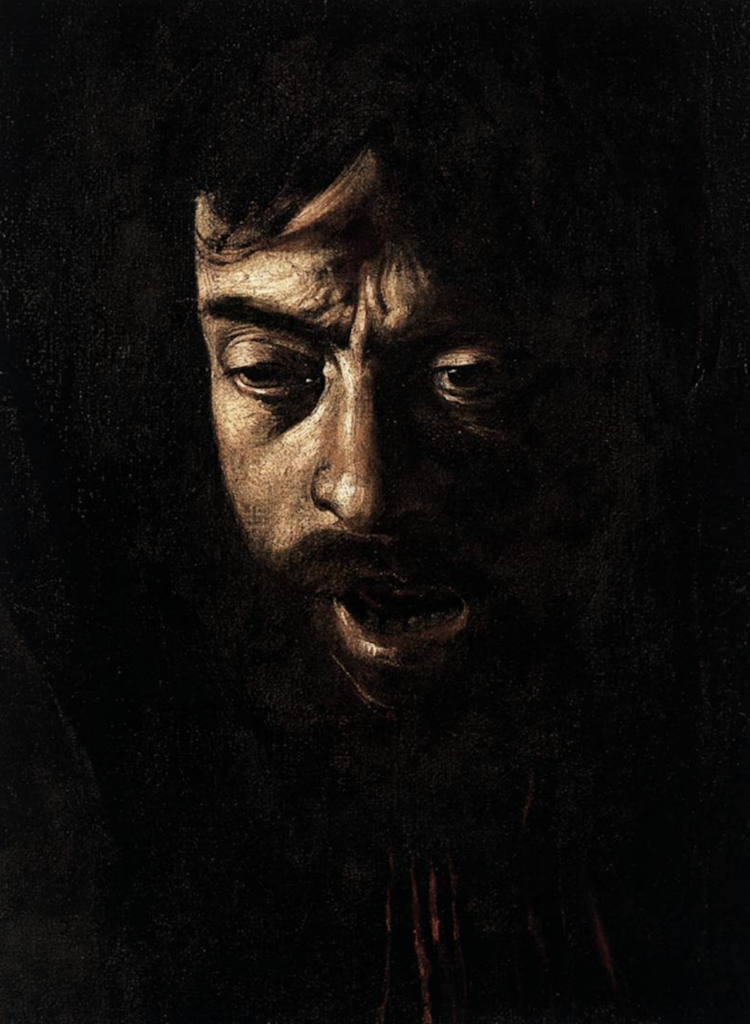
Caravaggio, David with the Head of Goliath (detail) 1609-10
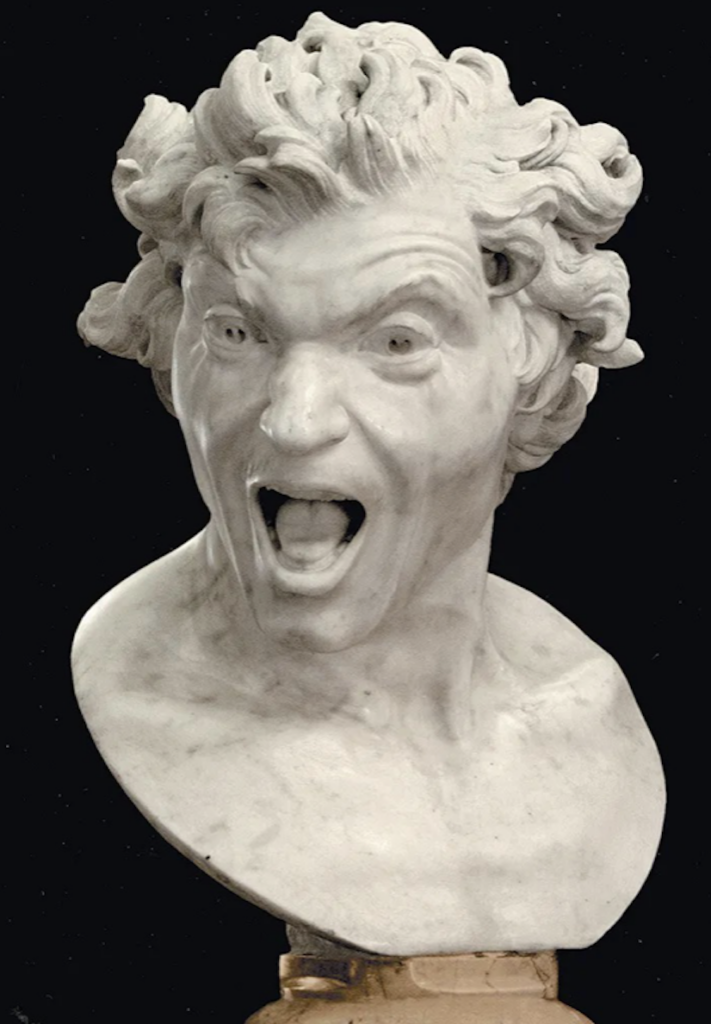
Gian Lorenzo Bernini: Anima dannata (Damned Soul), c. 1619
ARTH 2643-01 — Italian Baroque This course investigates the extraordinary age of the Baroque in Italy, often associated with artists such as Caravaggio, Gentileschi, Bernini, and Borromini. Our journey begins in Rome, considered to be the birthplace of the Baroque and the workplace of these artists. From there, we will travel to Bologna, Florence, Venice, Sicily, and Malta. We will study the profusion of artists, and their artworks and ambitious architectural programs in relation to the religious, socio-political, and cultural contexts of these regions. We will pay particular attention to the rampant competition and rivalry among artists, the impact of powerful and wealthy patrons, and the widespread legacy of the Italian Baroque.
This course is taught by Professor Barrett Tilney.
ARTH 2850–01 — Latin America II
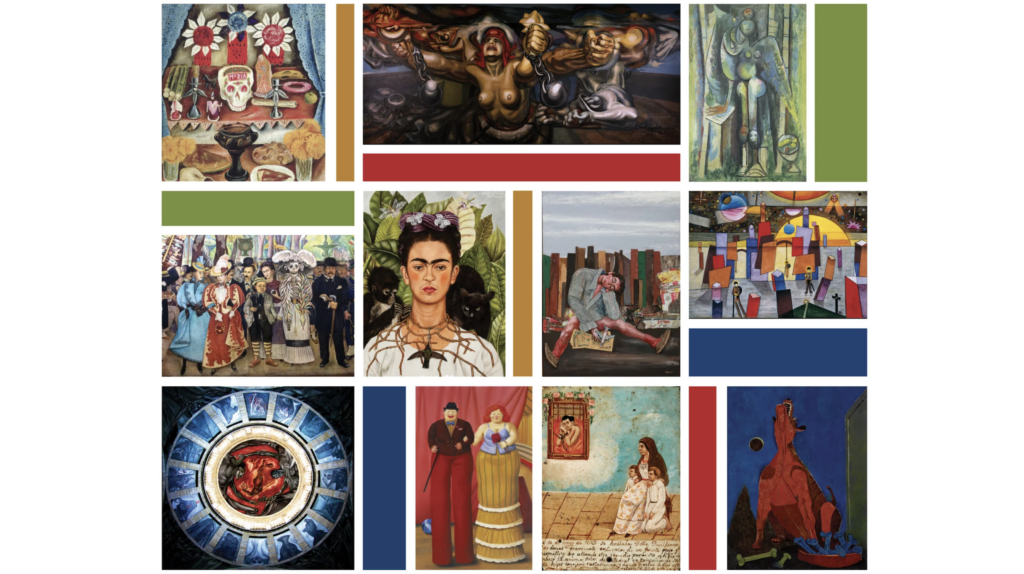
ARTH 2850–01 — Latin America II The course provides an in-depth analysis of Latin America through the art of Diego Rivera, Frida Kahlo, José Clemente Orozco, David Alfaro Siqueiros, Rufino Tamayo, Maria Izquierdo, Xul Solar, Antonio Berni, Wilfredo Lam, and Fernando Botero among others. By analyzing a wide variety of artistic production that includes painting, sculpture, performance, prints, manifestos, music, film, and ephemera, the course considers the diversity of Latin American cultural and artistic production, emphasizing artists’ relationship to religion, tradition, race, gender, justice, and politics. While considering Latin America’s enduring legacies and dynamic processes of change, it addresses several important art movements, such as modernism, surrealism, indigenism, social realism, muralism, and magical realism. Moreover, the course introduces students to the major artistic theoretical issues with an eye on the regional and global changes that defined, challenged, or helped shape Latin American art and culture.
This course is taught by Professor Andrea Gallelli Huezo.
ARTH 3510–01 — Picturing Death

ARTH 3510–01 — Picturing Death This course will explore many of the ways in which death has been represented, pondered, used, resisted, and embraced in the visual arts. Our main focus will not be on images of the dead and dying, but rather on Death itself—which cannot be fully captured by such terms as event, process, condition, or idea. Each week we will address an array of disparate artworks and readings brought together around one idea, such as time, memory, consequences, and equality. Most of our examples will be European and American art from the late middle ages to the present. This wide-ranging approach allows us to compare perceptions and uses of both art and death—which shape each other in countless ways. What do changing formulations of death – which is both universal and unknowable – tell us about the societies in which they appear? Why, for example, does death dance with the living in many late medieval images, loom silently from still life paintings in the 17th century, or explode into zombie hordes in the 21st? Class meetings are primarily discussion, with some lecture. Students’ main contributions include brief class presentations, short writing assignments, and a longer paper on a topic developed in collaboration with the professor. We will also make one or two class visits to area museums. Prerequisite: at least one Georgetown Art History course (ARTH-) or permission of instructor.
This course is taught by Professor Alfred Acres.
ARTH 3860-01 — Queer Art & Visual Culture

Felix Gonzalez Torres, “Untitled,” 1991; Clifford Prince King, “Just the Two of Us,” 2019; Nao Bustamante, “America The Beautiful,” 2002.
ARTH 3860-01 — Queer Art & Visual Culture This course surveys the production of queer art and visual culture from the mid-20th century until the present. The course utilizes queer, queer-of-color critique, feminist, and Black feminist theories, as well as performance, cultural, and affect studies to ground the emergence and growth of an expressly queer, trans, non-binary, and non-conformist identity and aesthetic in art. The course considers traditional and non-traditional modes of art production, including painting, photography, video, sculpture, new media art, installation art, performance art, public art, etc. Students will closely study, analyze, theorize, and contextualize works of art and trends by LGBTQ artists within an American and a transnational context.
This course is taught by Professor Andy Johnson.
ARTH 4122-01 — Arts of Zen Buddhism
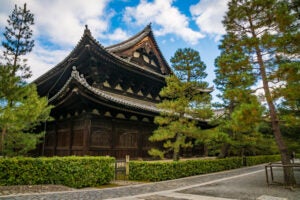
Daitokuji Temple, Kyoto, Japan
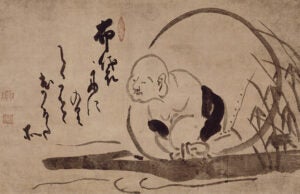
Hakuin Ekaku, Hotei on a Boat, Edo period (1615-1868), hanging scroll, ink on paper, Manyo’an Collection, 1998.56

Black Raku ware tea bowl, Momoyama period (1573-1615), pottery with black Raku glaze, black lacquer repairs, Freer Gallery of Art, F1902.52
ARTH 4122-01 — Arts of Zen Buddhism Zen Buddhism is one of the major traditions of Buddhism in East Asia and was moreover an instrumental force in shaping modern perceptions of Japan in the west. Over the course of the semester, we will analyze how the perceived distinctiveness of Zen Buddhism – as marked by concepts such as mind-to-mind transmission, master-disciple lineage, and sudden enlightenment – was constructed through the visual arts and how the arts in turn contributed to monk-patron relations and the cultural lives of monks outside the monastic walls. Among the weekly topics to be covered are: ink landscape paintings, portraits of Zen masters, the tea ceremony and ceramic tea wares, as well as Beat Zen and the impact of Buddhism upon postwar artists in the United States.
This course is taught by Professor Michelle Wang.
ARTH 4780-01 — Museum Architecture
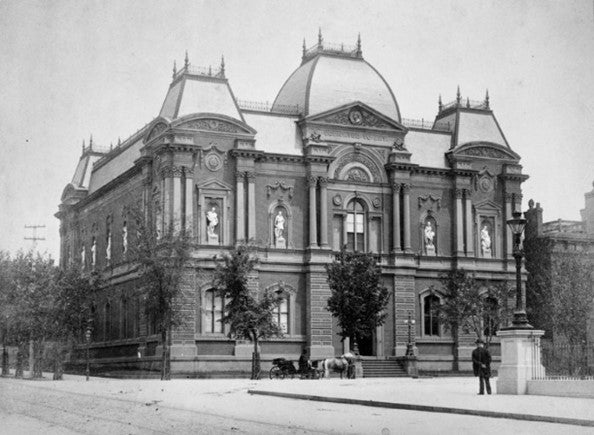
James Renwick. Renwick Gallery of Art (original Corcoran Gallery of Art). Washington, DC Begun 1859

Jean Nouvel. Louvre Abu Dhabi, United Arab Emirates. 2017 photo by Mohamed Somji
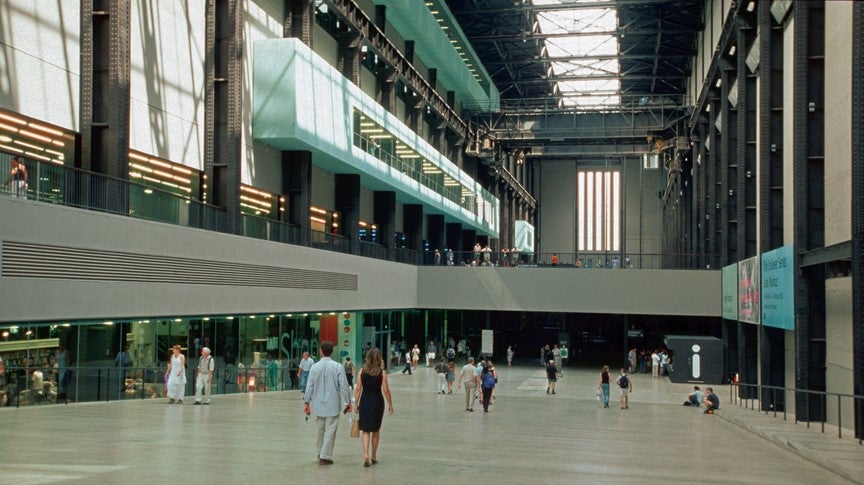
Herzog & de Meuron. Turbine Hall at the Tate Modern [adaptive reuse of the Bankside Power Station] London, England. 2000
ARTH 4780-01 — Museum Architecture Museum architecture shapes visitors’ experience of works of art and plays an integral role in the life of a city or region. In this course students will think critically about the architecture of the art museum. Questions to be considered include: How does architecture contribute to a museum’s visiting culture? What is architecture’s appropriate role – should buildings be at the forefront of a visitor’s experience or remain as a backdrop? How might a structure reflect the culture and art collection it presents? How have signature buildings impacted an area’s economic standing? Among others, the work of designers such as Renzo Piano, Tadao Ando, Zaha Hadid and Snøhetta will be explored. Case studies addressing institutions such as the Metropolitan Museum, the Art Institute of Chicago and the Louvre will be analyzed. Students will gain familiarity with field scholarship, visit multiple area museums, lead short discussions, and complete a longer research paper.
This course is taught by Professor Stephanie Rufino.
ARTH 4860-01 — Curating the Exhibition
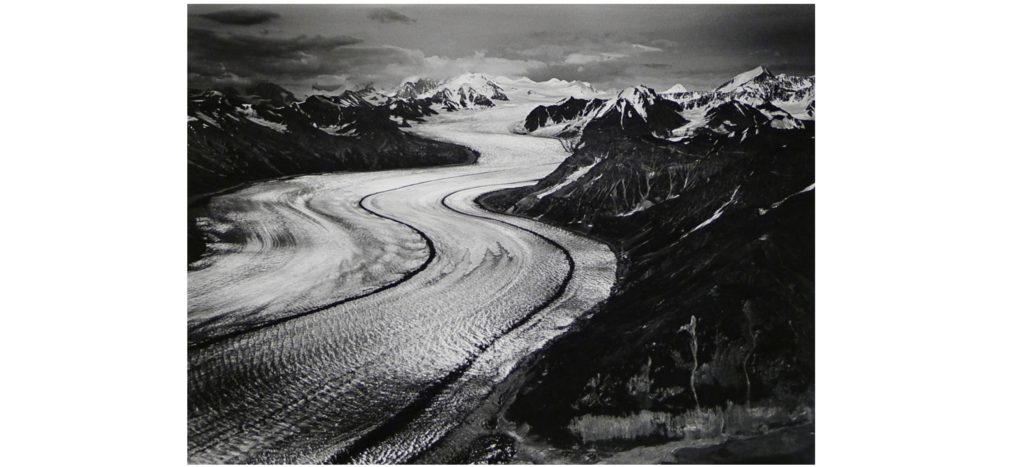
Marilyn Bridges, Kahiltna Glacier, AK (1990), gelatin silver print. Georgetown Special Collections.
ARTH 4860-01 — Curating the Exhibition This is a small seminar focused on the curation of a single exhibition at the GU galleries. Specifically, participants will collaborate with the instructor to put on an actual show at the Spagnuolo Gallery, which will go up in the Spring semester. In the process, we will discuss photography history, exhibition histories, key debates in curatorial studies, and what it means to design a show in specific cultural and institutional contexts. The exhibition will draw from the significant photo collections at GU, and be taught in conjunction with the Lauinger special collections team.
This course is taught by Professor Ian Bourland.
ARTH 4950-01 — Museum Fieldwork: Directed Study
ARTH 4950-01 — Museum Fieldwork: Directed Study Students must have 9 credits in Art History and the advisor’s approval required. Only art history Junior and Senior majors or minor students.
This course is taught by Professor Ian Bourland.
ARTH 4998-01, -02, -03 — Senior Thesis
ARTH 4998, Senior Thesis: By arrangement with a faculty adviser, majors may write a senior thesis on an art historical topic of their choosing. The thesis is optional but can serve as a capstone course that prepares students for future professional or graduate work.
This course is taught by Professors Alfred Acres, Ian Bourland, and Michelle Wang.
Art & Museum Studies Courses
AMUS 5100–01 — Museum Studies Foundations
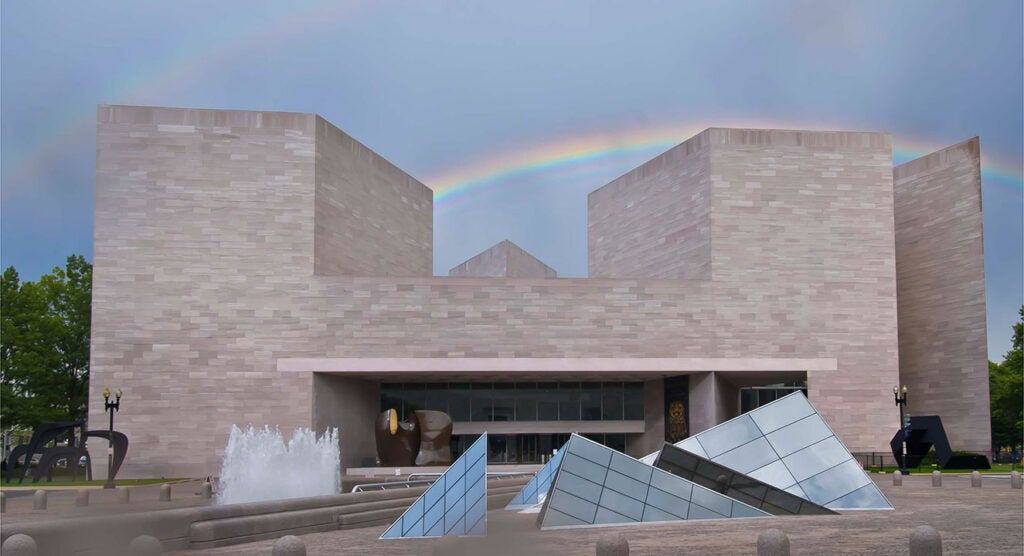
East Building, National Gallery of Art, Washington D.C.
AMUS 5100-01 — Museum Studies Foundations This course introduces students to the state of museums as well as their core functions, history, and critical literature. We will examine recent debates about museums through the lens of gender studies, disability studies, critical race theory, decolonization, and environmental sustainability, with particular attention to social media movements currently calling for change. Assignments will focus both on mastering key concepts in museum studies and on considering how we can change museums to better fit society. Our focus will be on art museums, but selected topics in historic and ethnographic museums will also be considered.
This course is taught by Professor Lisa Strong.
AMUS 5202-01 — Collections Management

Proper handling of objects
AMUS 5202-01 — Collections Management This course focuses on general museum concepts and procedures as they relate to collections (objects and their documentation) and their management (e.g., preparation, preventive maintenance & conservation, housing, problem-solving) as a whole. The course objectives are to introduce the participants to basic care and preservation of collections as well as a basic understanding of the history and current status of the governance of cultural materials. By the end of the course, participants should understand the definition and role of collections within a museum context; understand the philosophy of cultural preservation and the meaning of cultural patrimony; understand the importance of collection ethics and the role of collections within museum accountability and accreditation programs; understand the importance of a collections management policy, its development, content, and application; and how such a policy governs the daily activities within a museum’s collections.
This course is taught by Professor Jerry Foust.
AMUS 5204-01 — Museum Education and Interpretation
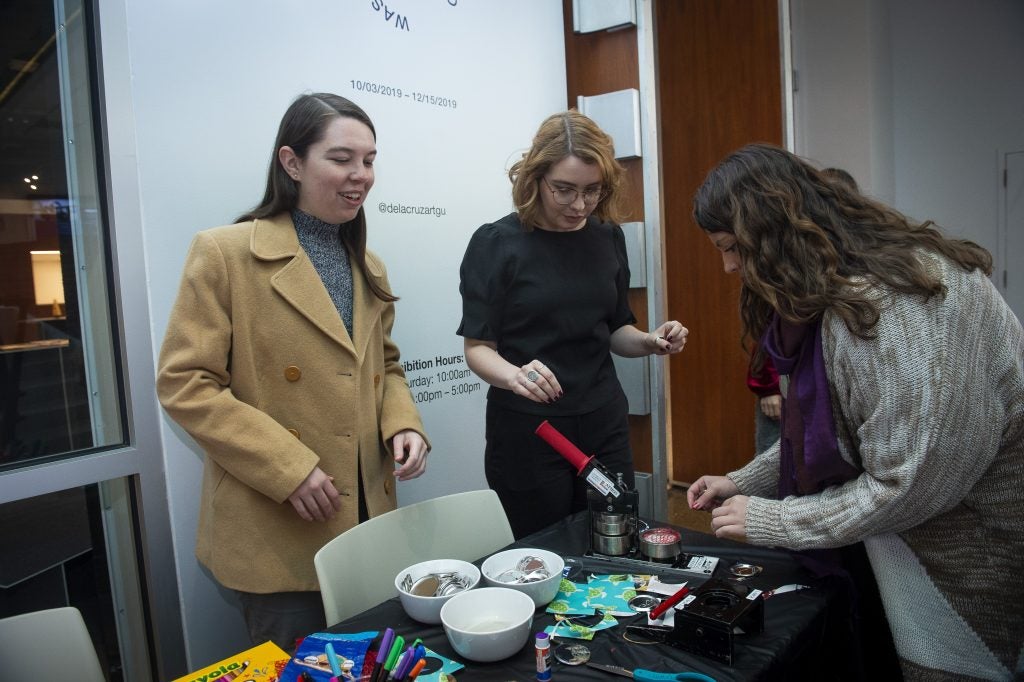
Students in Museum Education and Interpretation prepare for a program at the Maria & Alberto de la Cruz Gallery, 2019.
Copyright ©2019 Lisa Helfert for Georgetown University.
AMUS 5204-01 — Museum Education and Interpretation Students will be active participants in learning about museum education theories and practices. This course situates the functions of museum education and interpretation within the broader context of a changing paradigm in museums. During site visits to area art museums, educators will discuss aspects of interpretation, programming, and research that are unique to their museum. Class discussion will include such topics as how visitors learn in an art museum, new approaches to interpretation, education programming for varied audiences, building audiences and community, and the relationship of mission to education and interpretation.
This course is taught by Professor Anna Hindley.
AMUS 5206-01 — Curatorial Studies

Artist Hung Liu with her works Rat Year 2020 II, The Last Dandelion and Rat Year 2020 I, Counting Down. Both artworks, Collection of the National Portrait Gallery, Smithsonian Institution.
AMUS 5206-01 — Curatorial Studies In this course, students will create an exhibition that will open at the Georgetown University Art Galleries in January 2025. Through the study of Chinese American artist Hung Liu (born Changchun, China 1948-died, Oakland, California 2021), students will learn about how curatorial work can be an activist platform for visualizing previously unknown or buried histories, representing artists who have not been written widely into art historical narratives, and contributing to creating an artist’s legacy. We will examine Liu’s position in different contexts including private and public collections as well as different types and sites of exhibitions. With writing assignments and site visits/guest speakers students will learn about behind-the-scenes work that goes into securing an artist’s legacy through placement of artwork in institutions, publications that utilize archival research, and exhibitions. The course will culminate in the students’ production of an exhibition at the de la Cruz Gallery on a specific series that Hung Liu created from 2011-2012 in which the artist adapted and subverted Maoist propaganda cartoons that were published during the 1950s in small booklets for children in China. Former Smithsonian curator and director of the Hung Liu Estate, Dr. Moss will work closely with students on their contributions to the development of the exhibition including access to the artist’s archive, label text, essays to be published in the exhibition booklet, graphic design, and the planning of interdisciplinary programming for the university and wider community.
This course is taught by Professor Dorothy Moss.
AMUS 5207-01 — Museums and Digital Media

Digital and digitized objects from the Smithsonian collection.
AMUS 5207-01 — Museums and Digital Media Within the span of just a few decades, digital technologies have made a profound impact on museums: from how they operate to how the visitor experience is constructed. With an emphasis on interpretation and outreach, this course will explore the impact of technology on museum approaches to collections, exhibitions, and education. A variety of digital media platforms will be covered, including websites, social media, in-gallery interactives, and mobile experiences. We will immerse ourselves in key issues that guide and frustrate the successful implementation of technology in 21st-century institutions, such as openness, collaboration, sustainability, and a focus on the museum audience as users. With the help of case studies and guest speakers, we will explore what’s possible—and what’s challenging—when it comes to museums and technology.
This course is taught by Professor Darren Milligan.
AMUS 7951-01 — Fall Internship
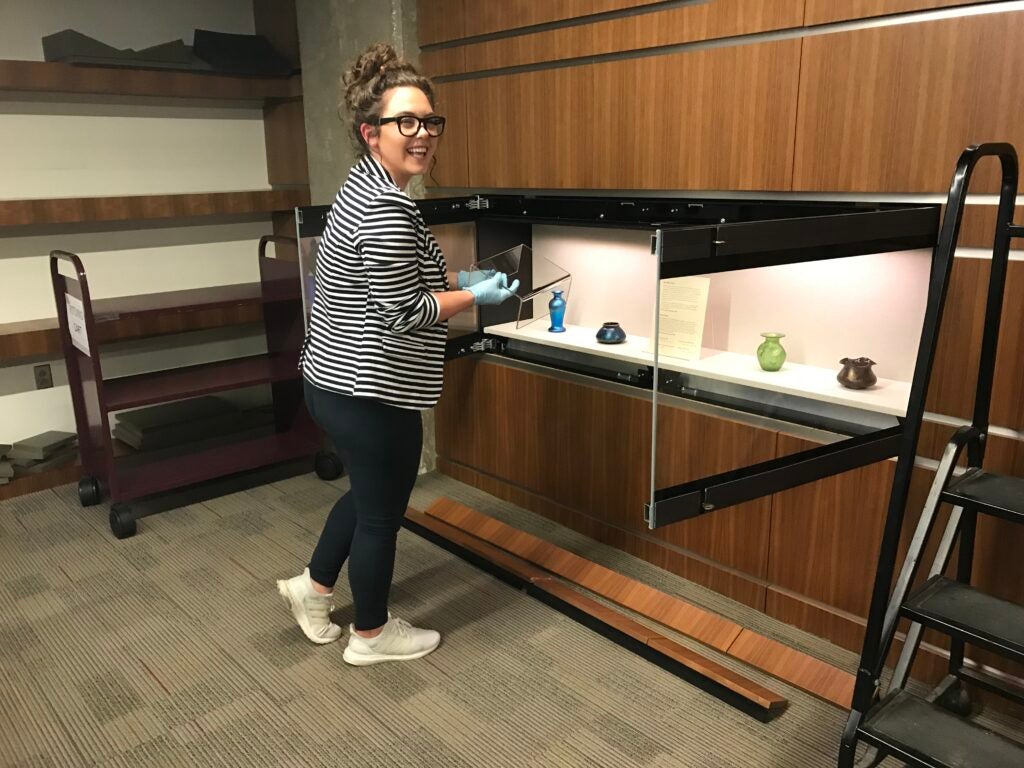
An Art and Museum Studies student installs her exhibition at Booth Family Special Collections, Georgetown University
AMUS 7951-01 — Fall Internship Museum internships provide concentrated practical experience within selected museum departments as well as an overview of the operations of a museum. Some of our internships include a staff-directed seminar; most involve a linked research project as well as an internship journal. Expectations and placement will be discussed during the orientation session. Schedule determined by student and museum supervisor; 15–20 hours/wk. Art and Museum Studies students only.
This course is taught by Professor Lisa Strong.